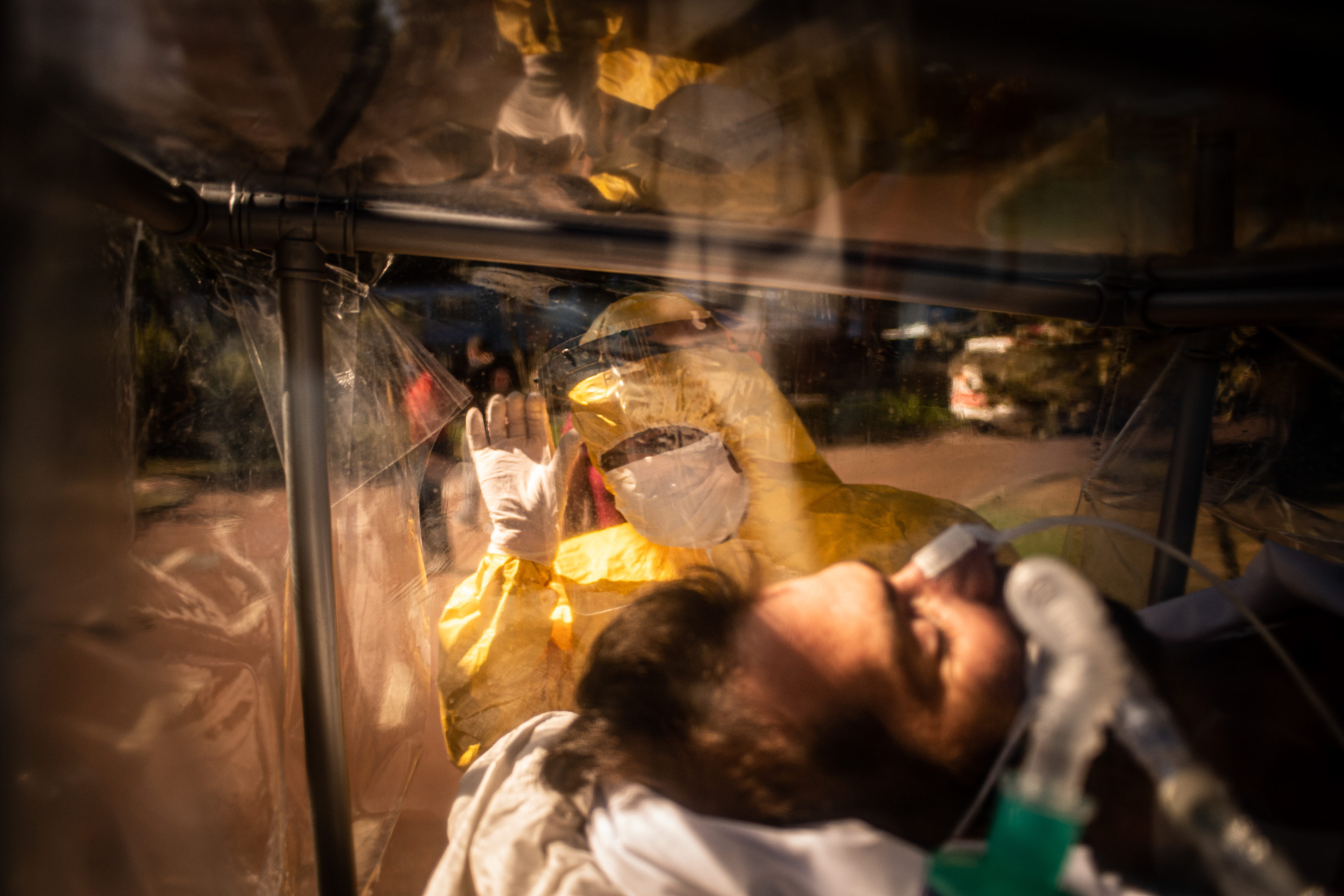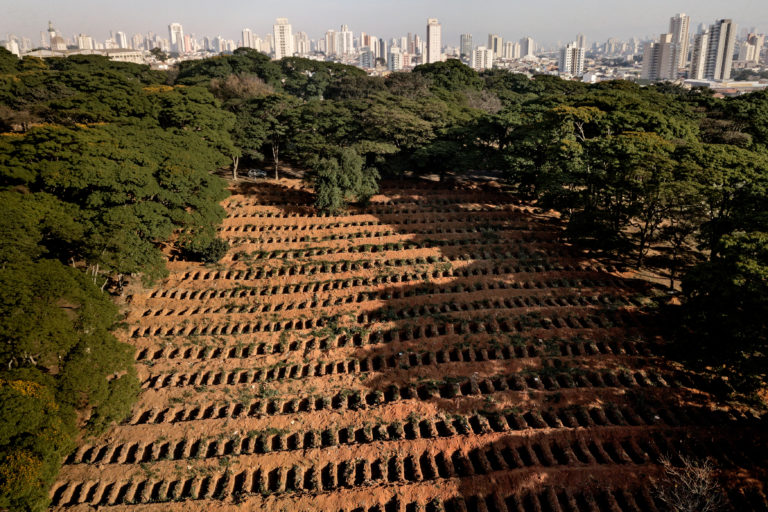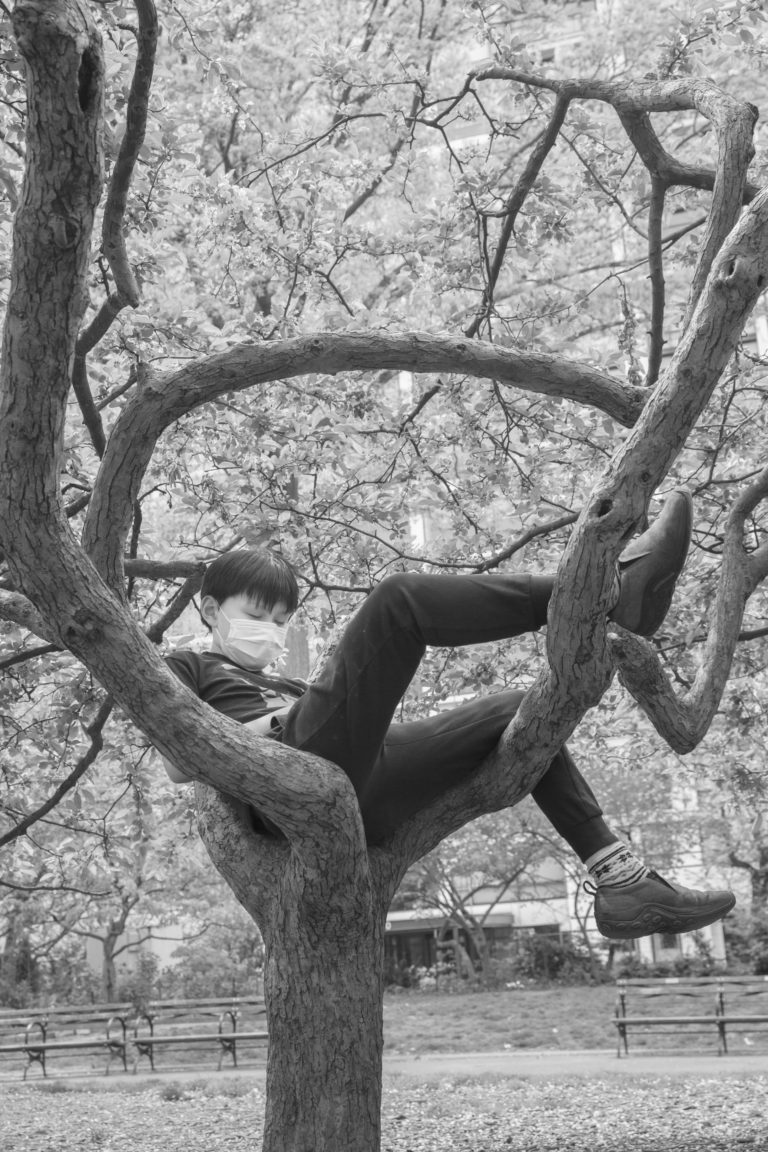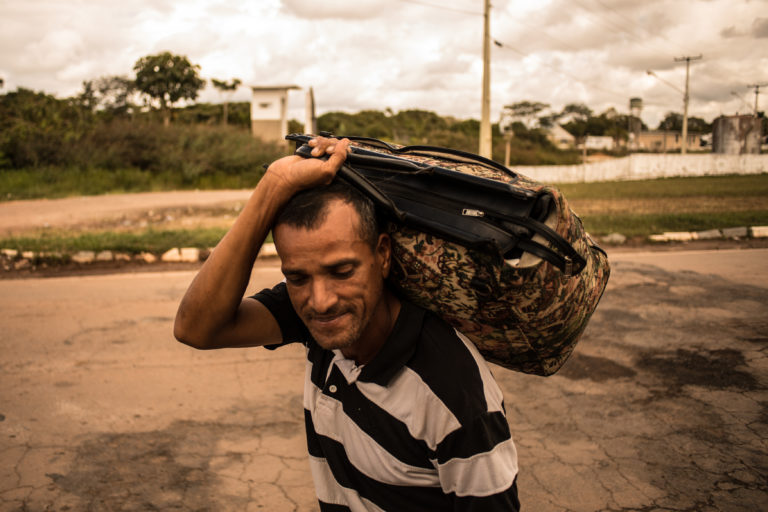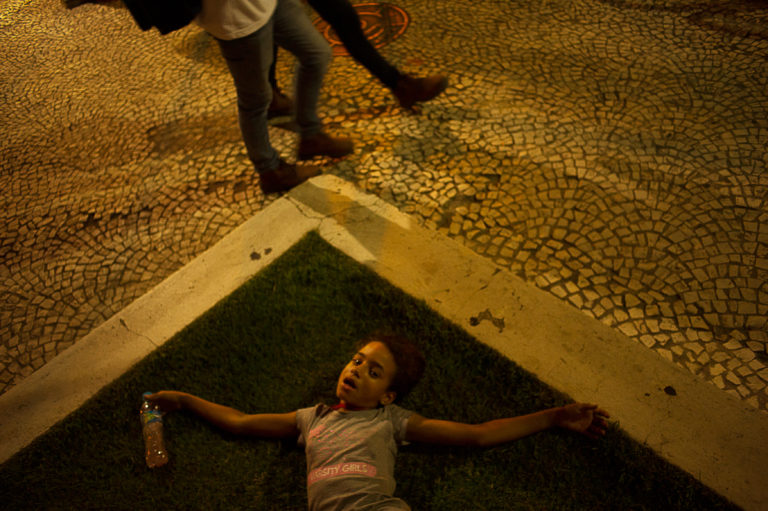The first months of the year 2020 may be remembered as the moment when the world stopped and for a few moments, cried.
From a distance, we observed what was happening in the Chinese city of Wuhan. With the emergence of a new virus for which there was no efficient medicine or therapy, the Chinese government isolated the entire Hubei region, the country’s 8th largest economic zone, trying to prevent the worst; the spread of the disease and the infection of hundreds of millions of Chinese citizens. Overnight, the free movement of more than 60 million people was forcibly interrupted. At the same time, by the thousands, patients died of suffocation in overcrowded hospitals, with their lungs stiffened, unable to oxygenate the blood of their bodies.
Almost like a bad dream, the apocalyptic idea of a deadly global health crisis like those of the black plague came to stalk the imagination of people around the world, but it was first in Italy and then in Brazil that this nightmare came true.
While the images made in Italy show how a small community in the south of the country faced the worst moment of the crisis, with the world still perplexed, crying daily with the growing number of people who lost their lives, the images made in Brazil, exposes the moment when populism and the politicization of the crisis negatively affected the population of the country that even today, (19/09/2020) continues to suffer from the death of thousands of people every week.
Italy
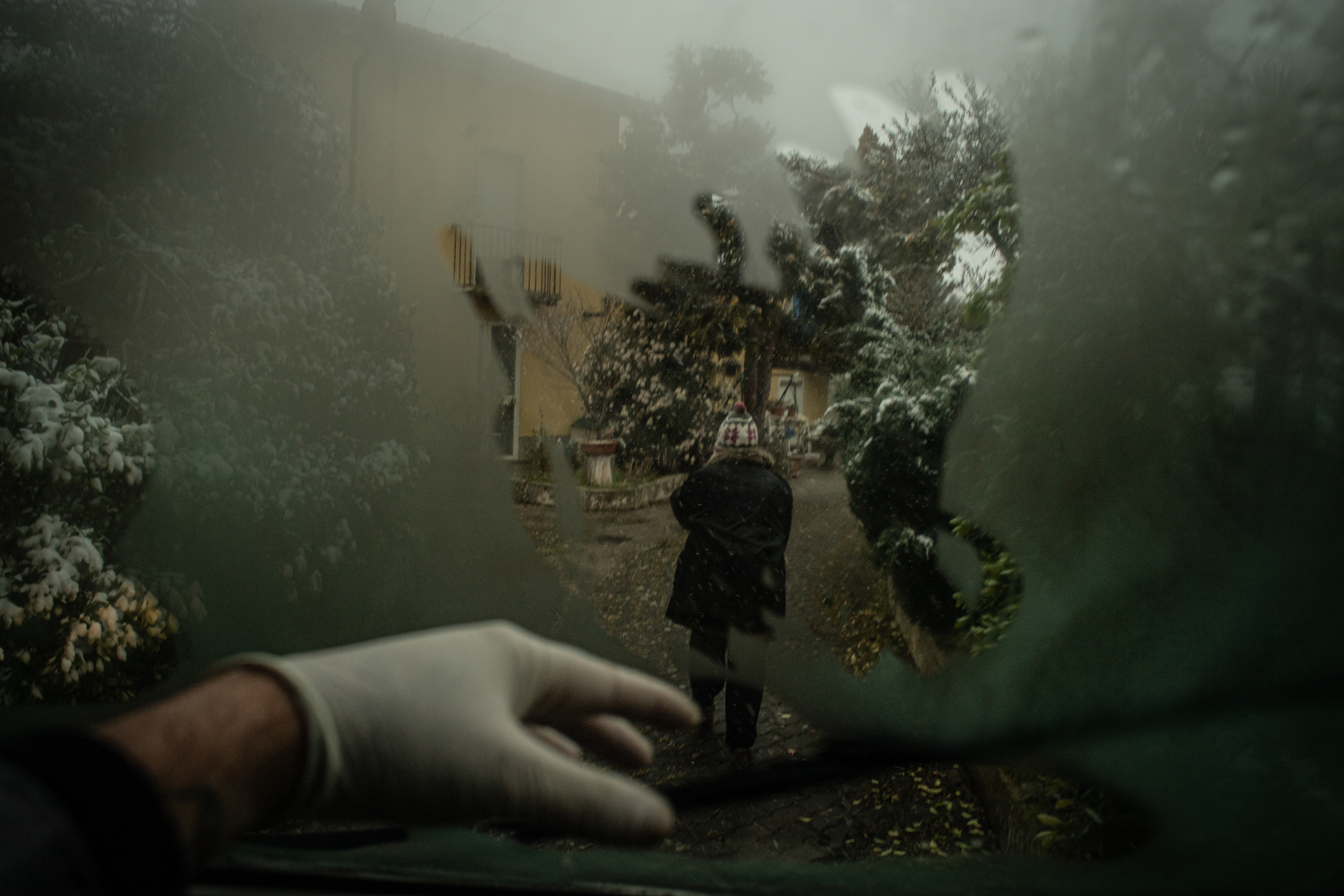
A quarantined woman at her home receives a package of medicines left by volunteers. Volunteers are deliberately prohibited from having any physical contact with individuals tested positive for COVID-19 disease. The city of Ariano Irpino is the main center of the disease in the region of Campania, in southern Italy and was declared a red zone by the central administration of the region.
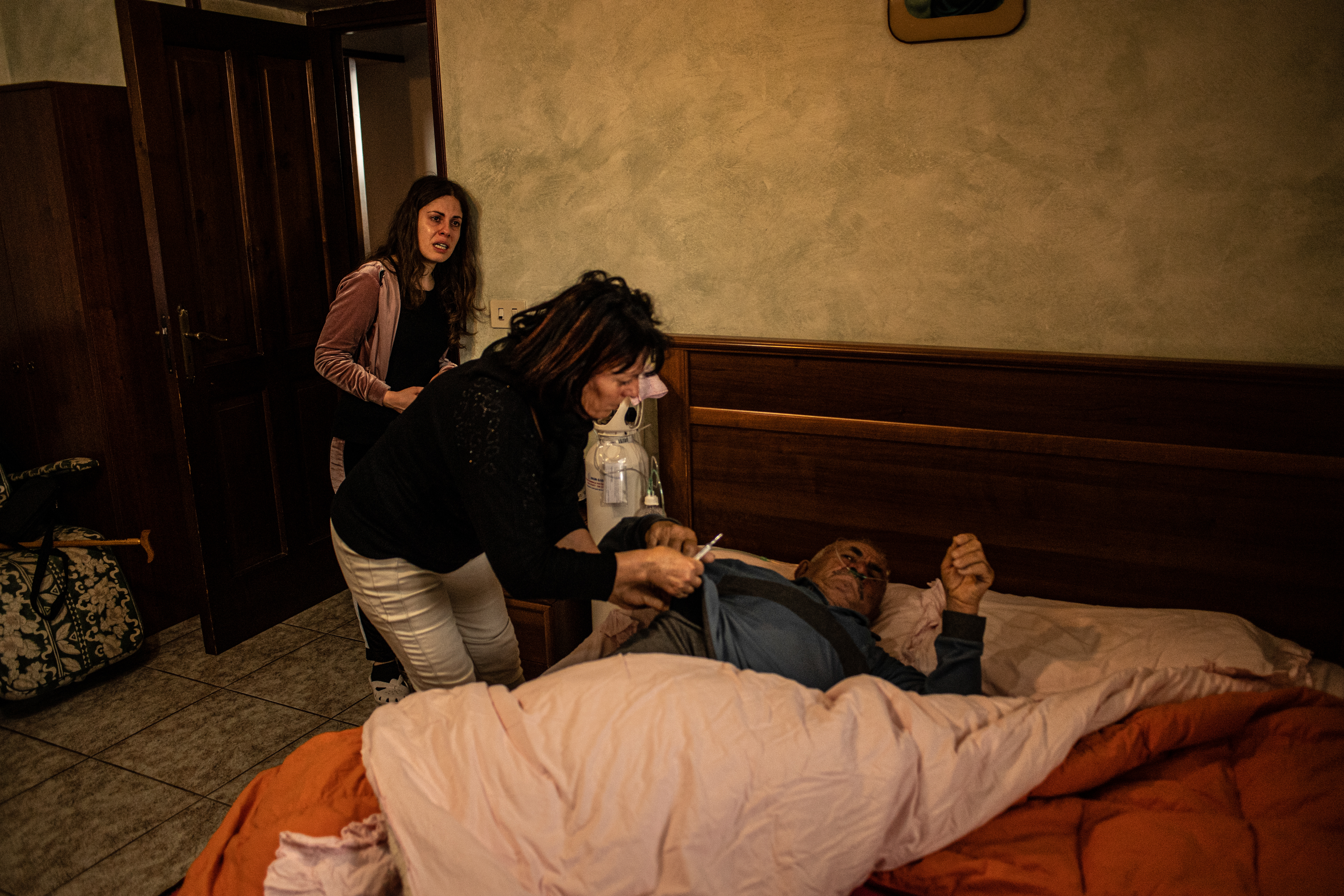
85 years old from the city of Ariano Irpino, have been feeling high fever and difficulty breathing, his lungs were not working properly saturating less than 85% of his blood that could compromise organ function, such as the brain and heart. He had wait for more than a week to receive help from the emergency service that are overloaded with work during the crises. The hospitals in the city and in the cities around didn't have any more available semi-intensive and intensive care unities free to accommodate new patients. In this picture, Angela, and her mother are measuring his body temperature
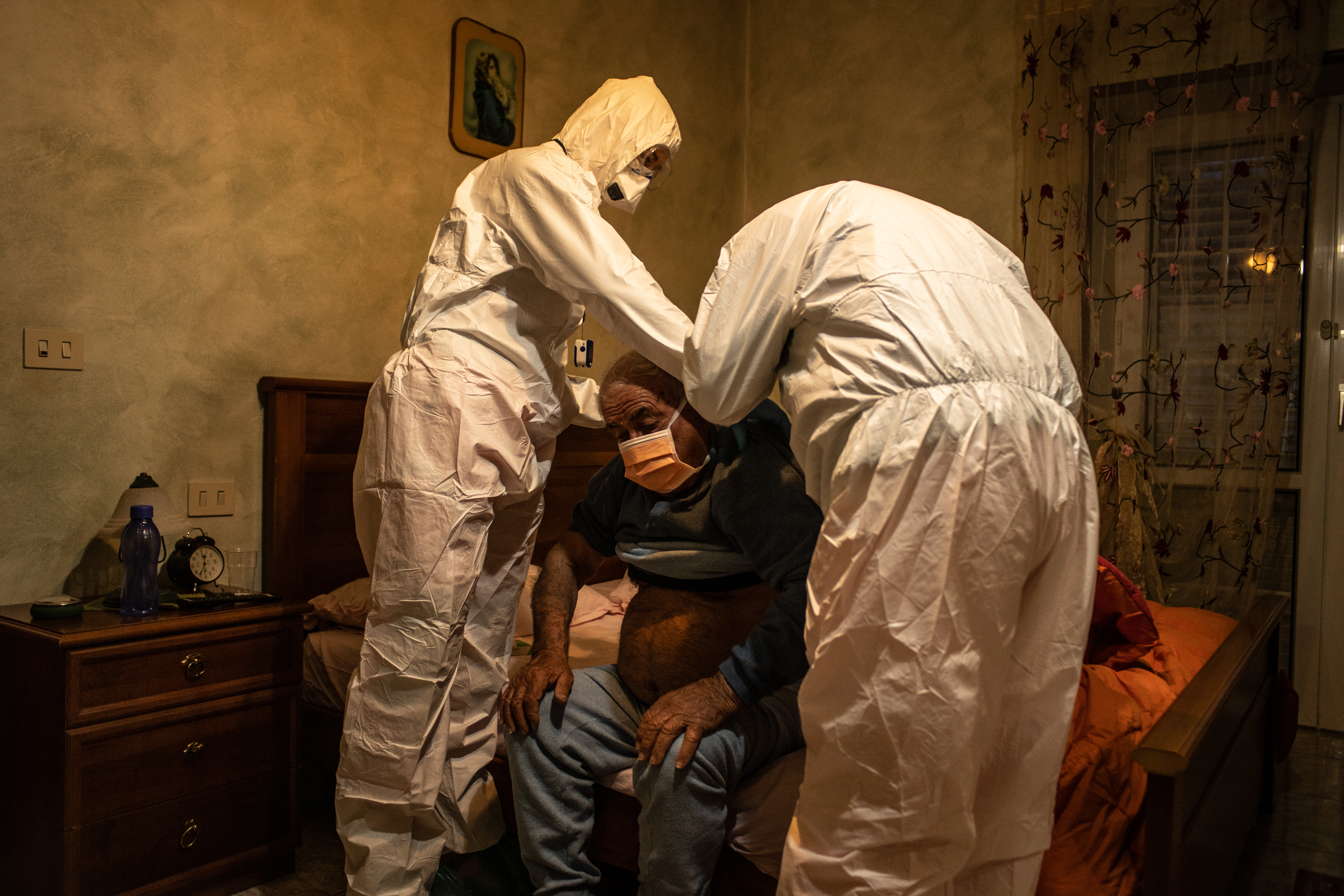
84-year-old retired farmer Guiseppe Guardabascio began feeling unwell a week before they called the emergency service. On the farm outside the Italian small town of Ariano Pirpino, he lived with his son, daughter-in-law and two nieces. Although, the family tried to keep him at home at the beginning of the sanitary crises, he kept making small trips to the store or going out to meet friends. Then the symptoms got worse. The fever rose to almost 40 degrees, he coughed, his breathing became heavier and heavier and he began to hallucinate. On March 27, the family called the emergency number without assistance. Late the next evening, the ambulance arrived with a doctor and a nurse and measured the lung capacity. The result was alarming. But they would not take the old farmer to the hospital. Instead, the family was told to go to the pharmacy to buy oxygen. There, her daughter-in-law was told that Guiseppe would die if he did not get to hospital quickly.
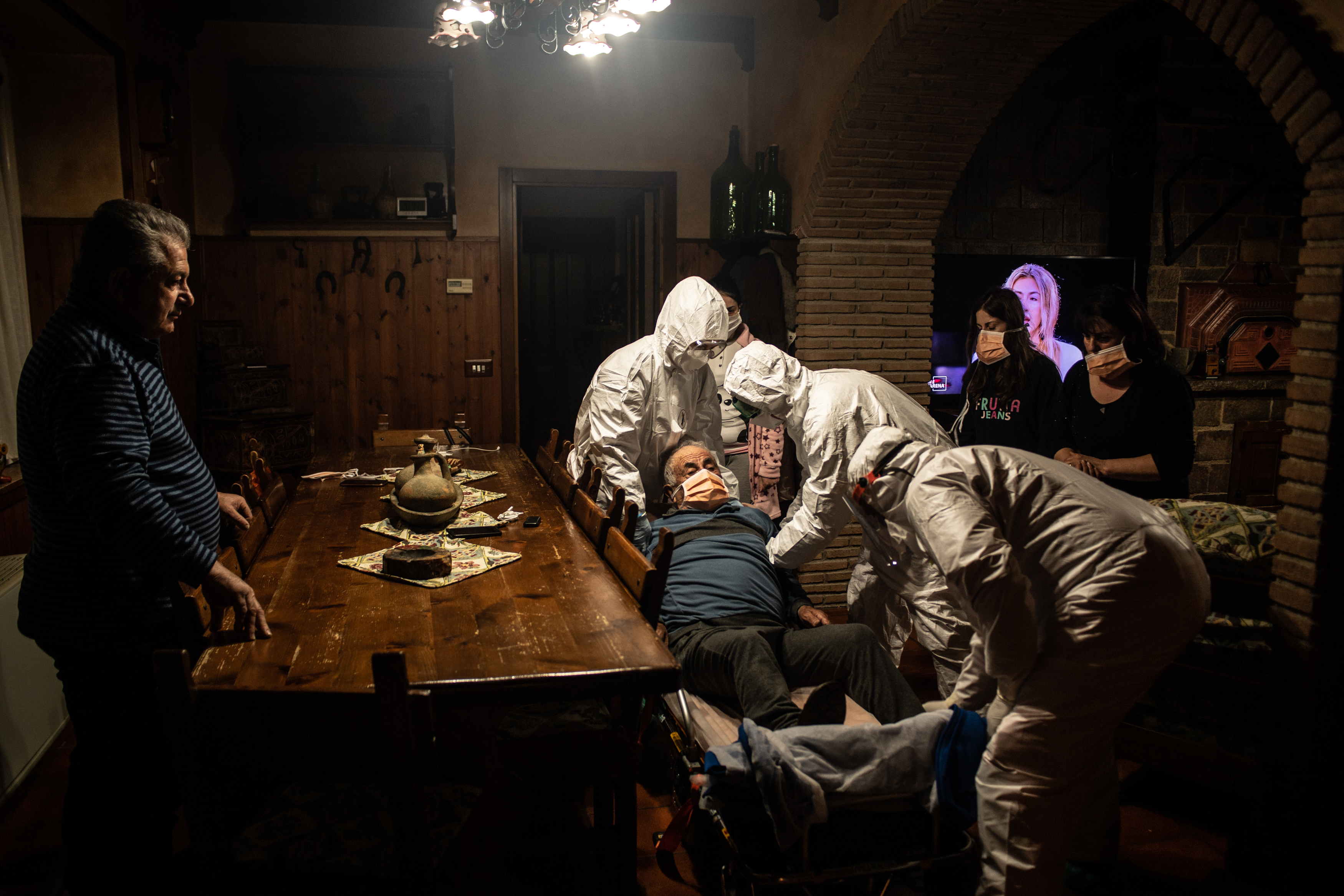
84 years old Giuseppe Guardabasci from the city of Ariano Irpino is been rescued by the 188 emergency. Giuseppe had severe COVID-19 symptoms for more than a week but the doctors refused to hospitalize him as the hospitals in the southern region of Campania are overfilled with infected patients.

Angela, calling the 118 emergency rescue service. 85 years old from the city of Ariano Irpino, have been feeling high fever and difficulty breathing, his lungs were not working properly saturating less than 85% of his blood that could compromise organ function, such as the brain and heart. He had wait for more than a week to receive help from the emergency service that are overloaded with work during the crises. The hospitals in the city and in the cities around didn't have any more available semi-intensive and intensive care unities free to accommodate new patients.
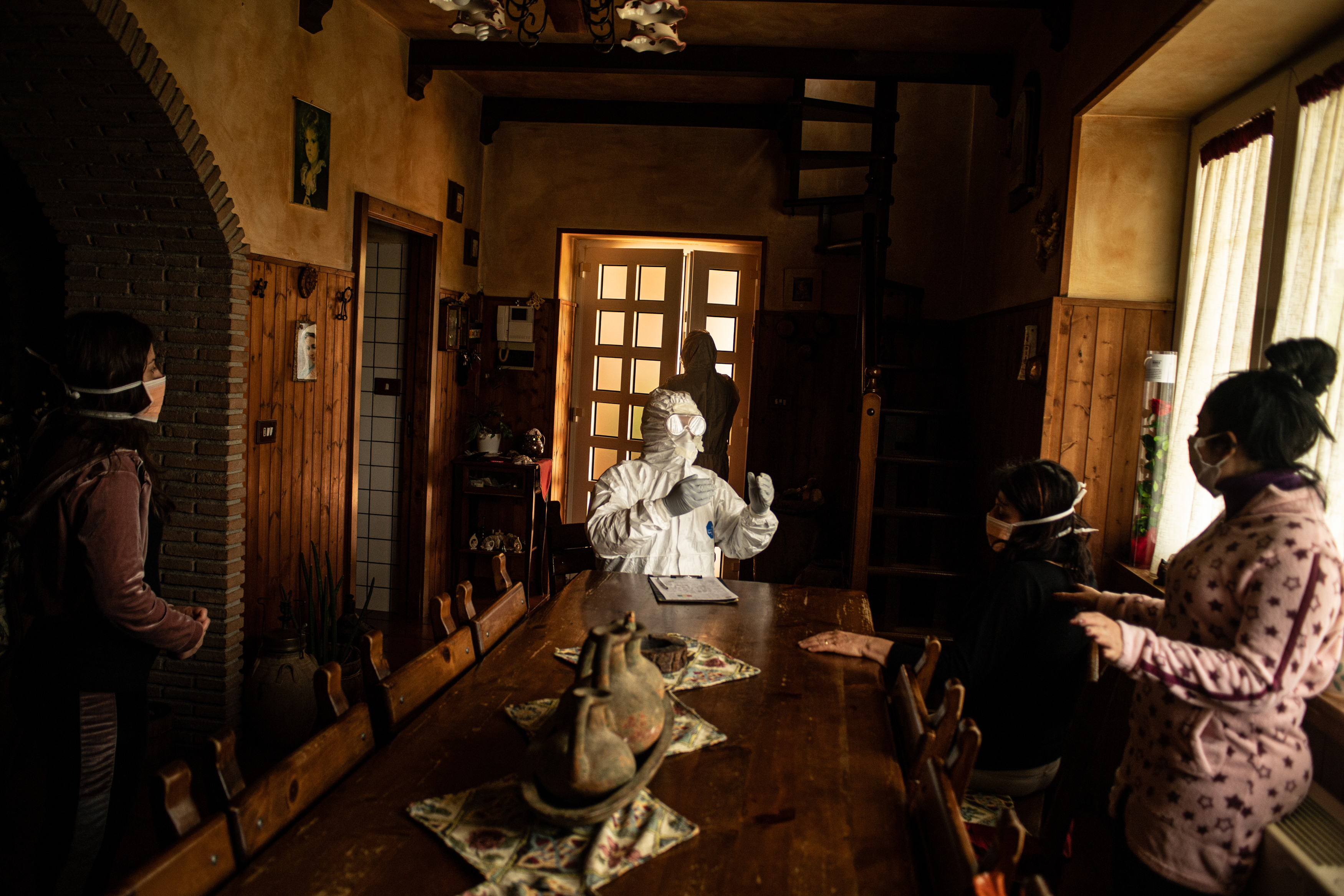
The doctor from the 118 emergency service telling the family that the hospitals in Ariano Irpino and in the surrounding cities are overloaded and that if they take their grandfather with them, he will probably have to wait in the ambulance for hours. " We can't make miracles"
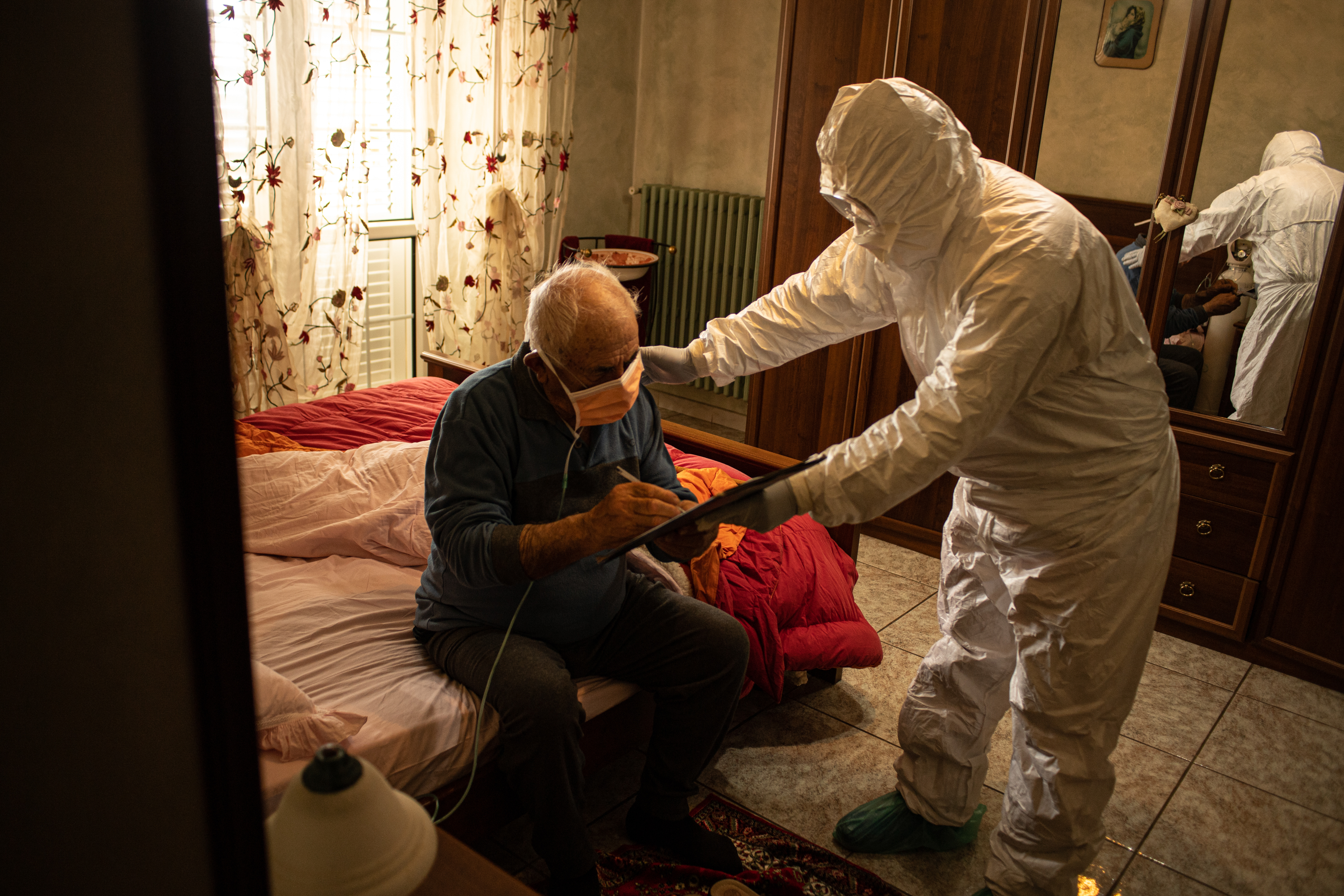
The family didn't agree with the doctor's decision of not taking the 85 years old sick man to the hospital and decided not to sign the term of responsibility. The doctor than asked the man to sign himself the term, confirming that he agreed to stay at home even if with the critical conditions he had.
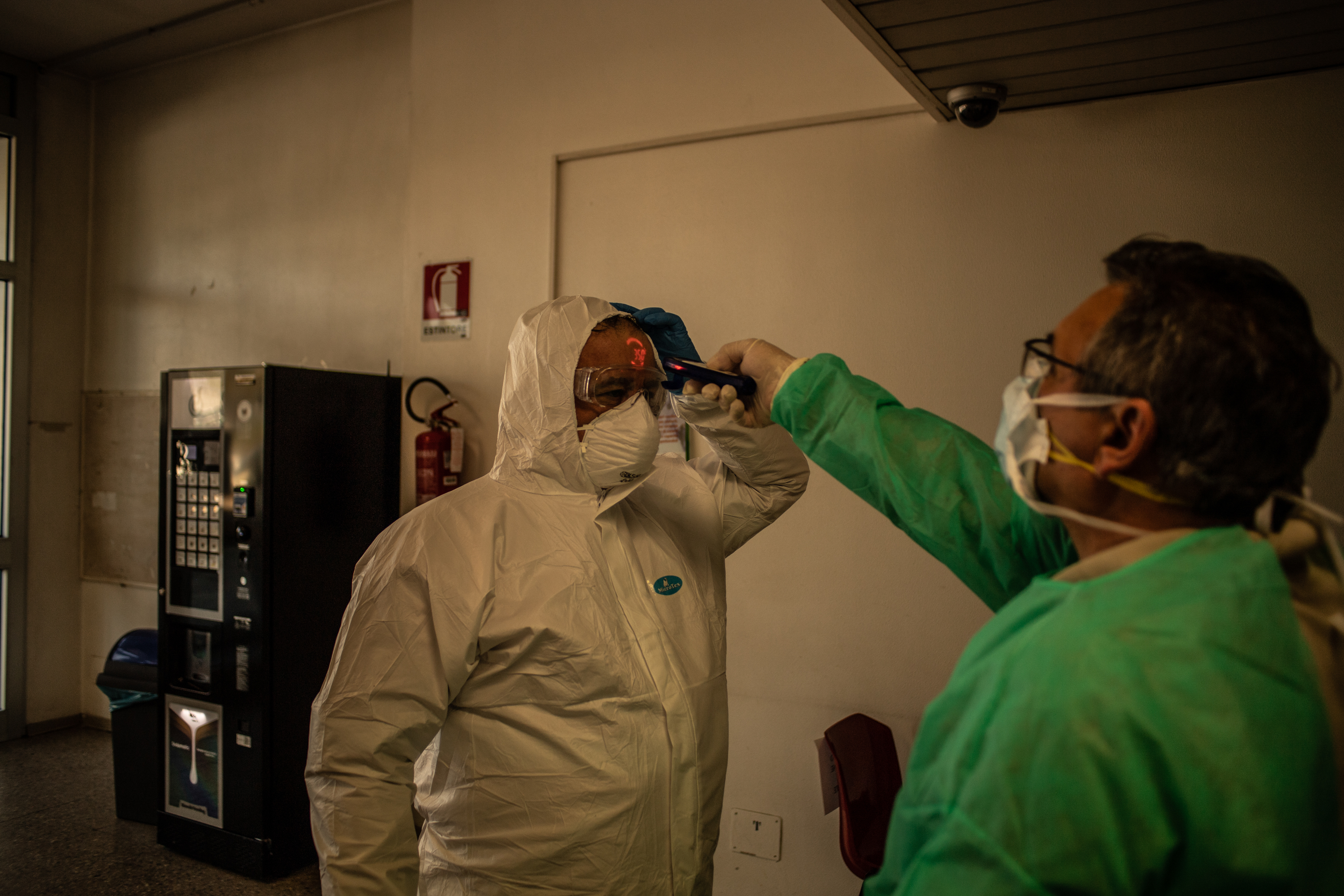
A doctor at the Ospedale Civili in Brescia measures the temperature of a Red Cross volunteer that arrived at the hospital to rescue a patient from the hospital and to take him to the Centro Paolo VI. A classic hotel owned by the church transformed in a quarantine facility for patients that have recovered from the disease but still need to wait in isolation for the two final tests confirming they are virus free.
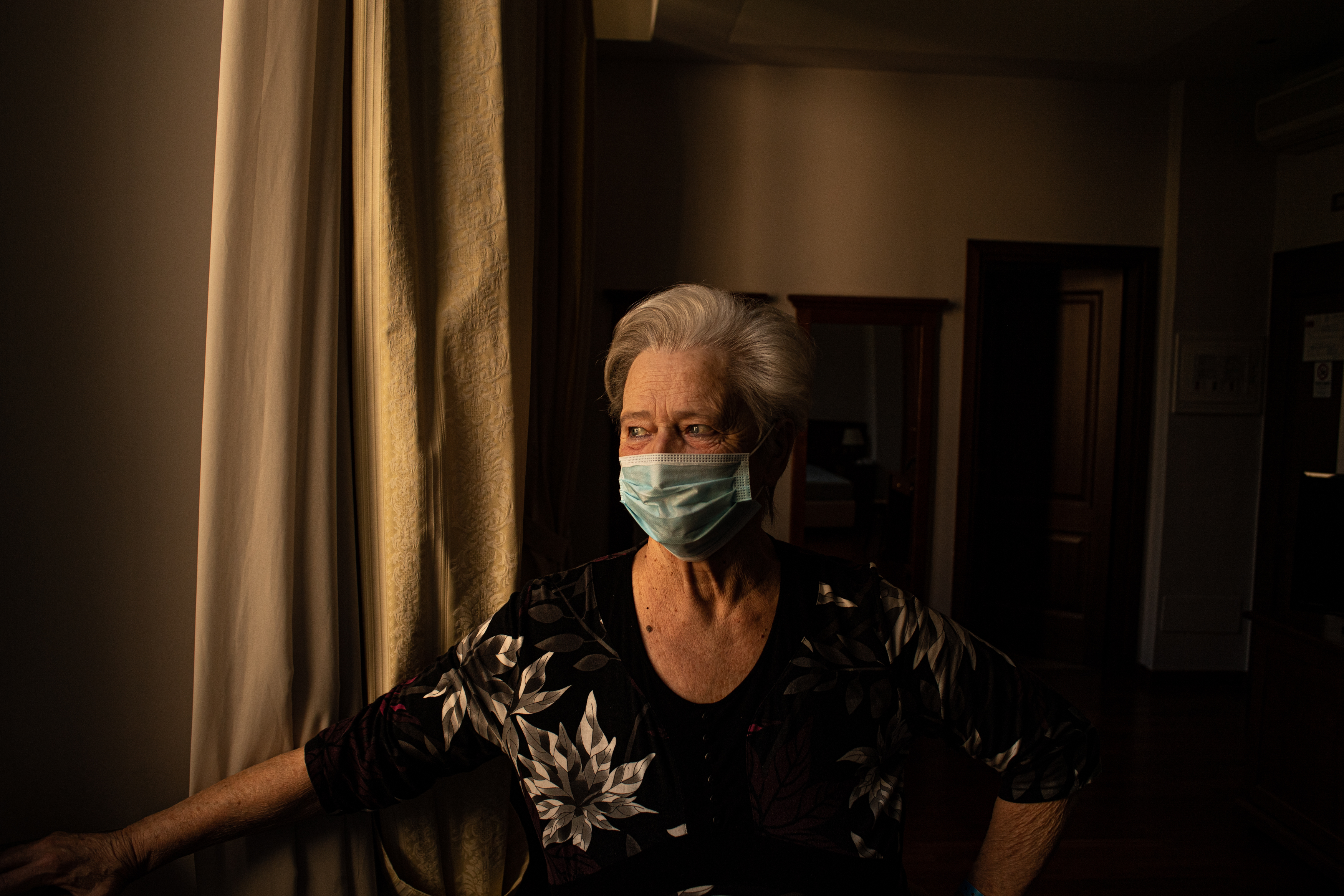
74 years old Angela stayed for 20 days at the hospital in Brescia recovering of COVID-19 It was the first time she ever gave an interview. She was feeling well, eating well, she was being well treat at the hotel. She was taken to the Centro Paulo VI after 20 days in hospital recovering from the COVID 19. She had been at the Centre for 5 days She says that she was really ill during the first 3 days at the hospital but later she started to react well with the treatments, that after a few days in the hospital, the doctors started to give her lighter masks and she slowly began to recover her breathing capacity. She had a lot desire to survive. She remembers better the first 3 days, she felt like she was wearing a dog collar, that was squeezing her neck very hard. They intubated her, but she was woken during all the time. Sometimes, when she felt thirsty, without being able to speak, she gave the doctors a signal showing she wanted to drink water, so they opened a kind of a tamp and gave her some drops of water. A few days later, she started to be able to see the nurses and doctors. She says that she has always felt well also there because of the way she has been treated by the doctors and nurses, they wanted her well. It was a horrible experience as a diseases she says, but she is very happy with how she finds herself now. She didn’t think about much during the time she was in the hospital. The first 3 days she couldn’t think anything, but after they took the respirator from her, heard from the doctors that she would make it, that she was reacting well, they gave her enthusiasm to fight and now she is happy and hopes that the worst has passed and that slowly she can come totally out of it. She has to wait for another 15 days there She has to wait for the final tests But she wants to go back home and start the life she had before. She is a retired but she worked as a volunteer in a coral, she was a volunteer with the sick, she always found something to do a bit of.
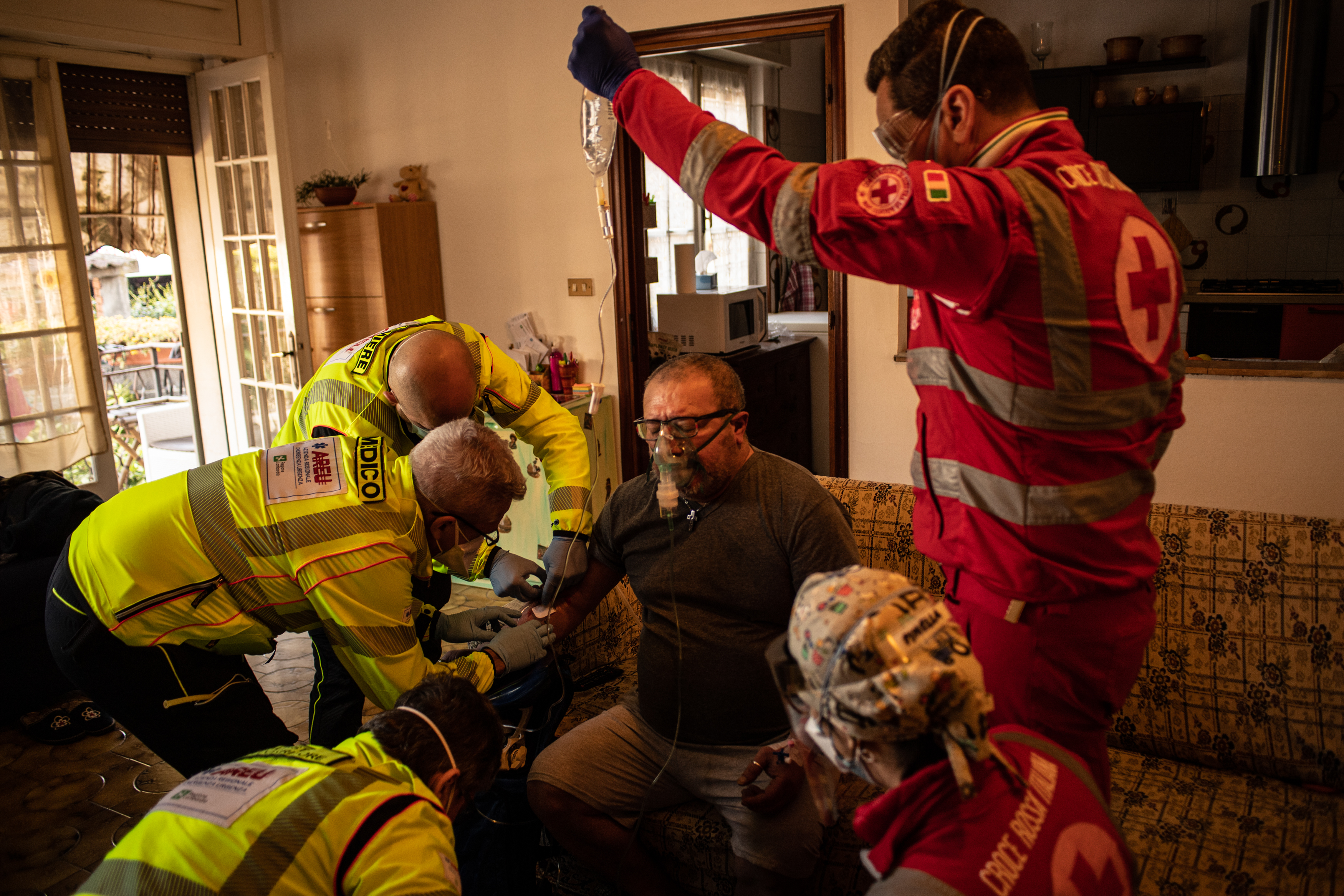
A 56 years old male, suffering of asthma. He lived with his wife and mother in an small house with two floors. He was short in height and slightly obese. His voice was grave and his face was tired. He was experiencing difficulties to breath for about 3 hours, complained of feeling his body submerged by mucous. Minutes after the arrival of the ambulance, a car from the emergency medical service came to assist the Red Cross emergency team, at one point, 5 persons, doctors and nurses were there to help the patient. They measured his pressure, his saturation and heart beating, medicated him with cortisone and hydrated him intravenously. The intervention lasted for about 30 minutes, his wife and mother followed it from a certain distance inside the house with their eyes expressing concern. The family sustained that they didn’t had any contact with infected or potentially infected persons, that they stayed mostly at home, following the government’s lines going out only to buy groceries and medicine when needed. The doctors advised him to stay at home, as he could easily deteriorate his health inside the very contaminated hospital in town. The patient recognized that his asthma has been in problem in his life. He answered no when the doctor asked if he was a smoker. Seating in the sofa, with his spine straight as he couldn’t curve it because of pain, surrounded by the ones who were the to help him, he was visibly tired and afraid when the doctors arrived, but released when the doctors left.
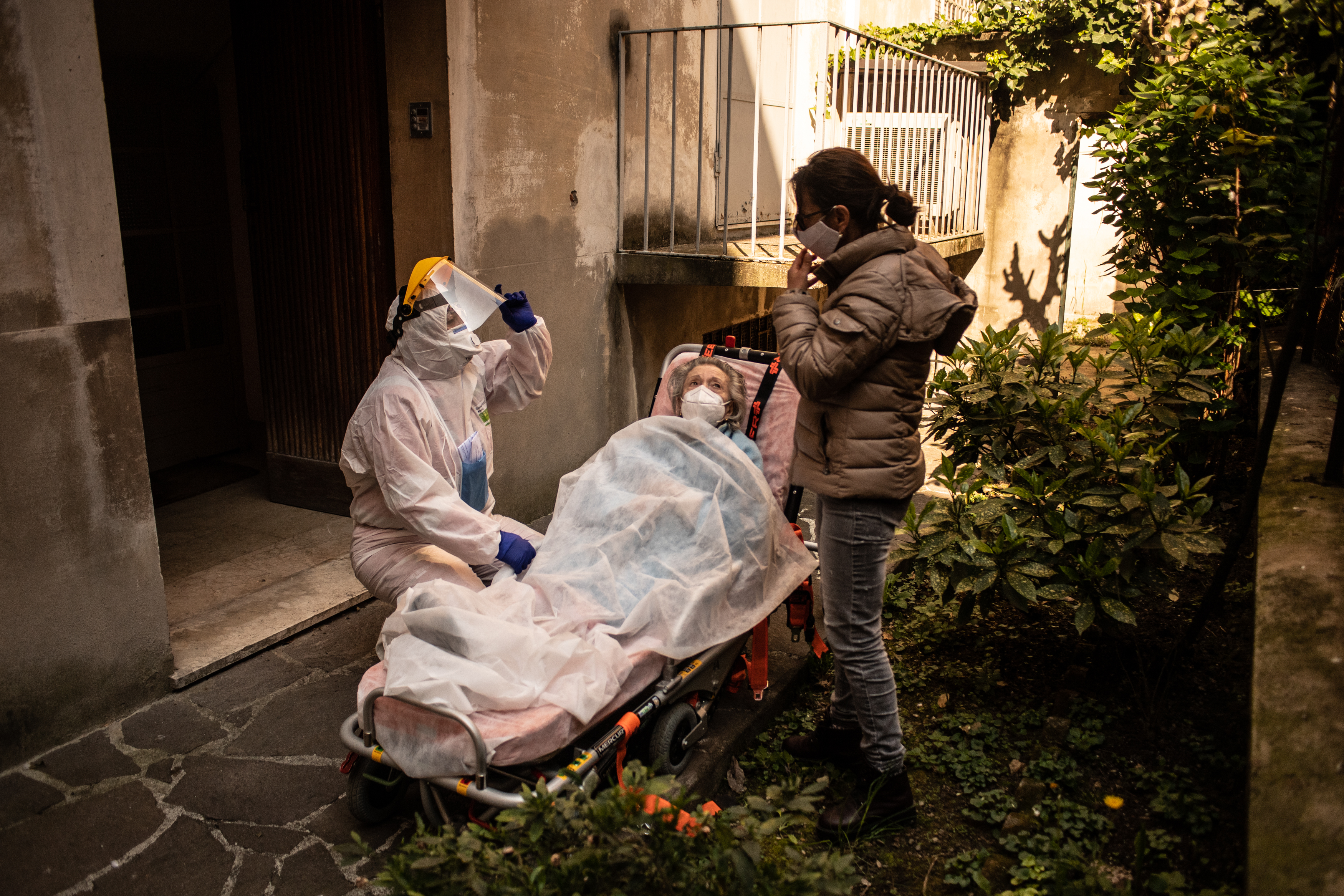
A 95 years old lady, living alone in her apartment. At the moment of the intervention, her granddaughter was there too. She had problems to breath and fever for about a week. She was seating on the right border of her bed, surrounded by pictures, specially the one reproducing a painting of the Madonna as the central one. The room was dark and full of other things, she had a stock in her hands, the Red Cross volunteer took it from her so she could measure her temperature, the old lady however, wanted the stock back after a few minutes. She answered all the questions quickly and clearly. She had never had a heart attack in her life and her blood pressure was low, 90/70. “No one ever died of low blood pressured” joked the second Red Cross volunteer. The team evaluated her condition as good, she even wanted to stand-up alone to put her right arm back through the sleeve of her pyjamas, but was asked by the volunteer not to. They didn’t need her to break her femur if she fell in the floor. Normally, under the today’s Italian “normal”, she wouldn’t be taken to the hospital where she could be infected in case she is not but the old lady wanted so and the team followed her request. She was taken to a department isolated from the COVID Patients. The Red Cross doctor said “She is 95 years old, life is also leaving her as it does with all of us at some point”. She seems to be just as stronger as her age allows her to be. Leaving the building, a neighbour came out from the her window and wished her good luck asking her to come back home as soon as possible.
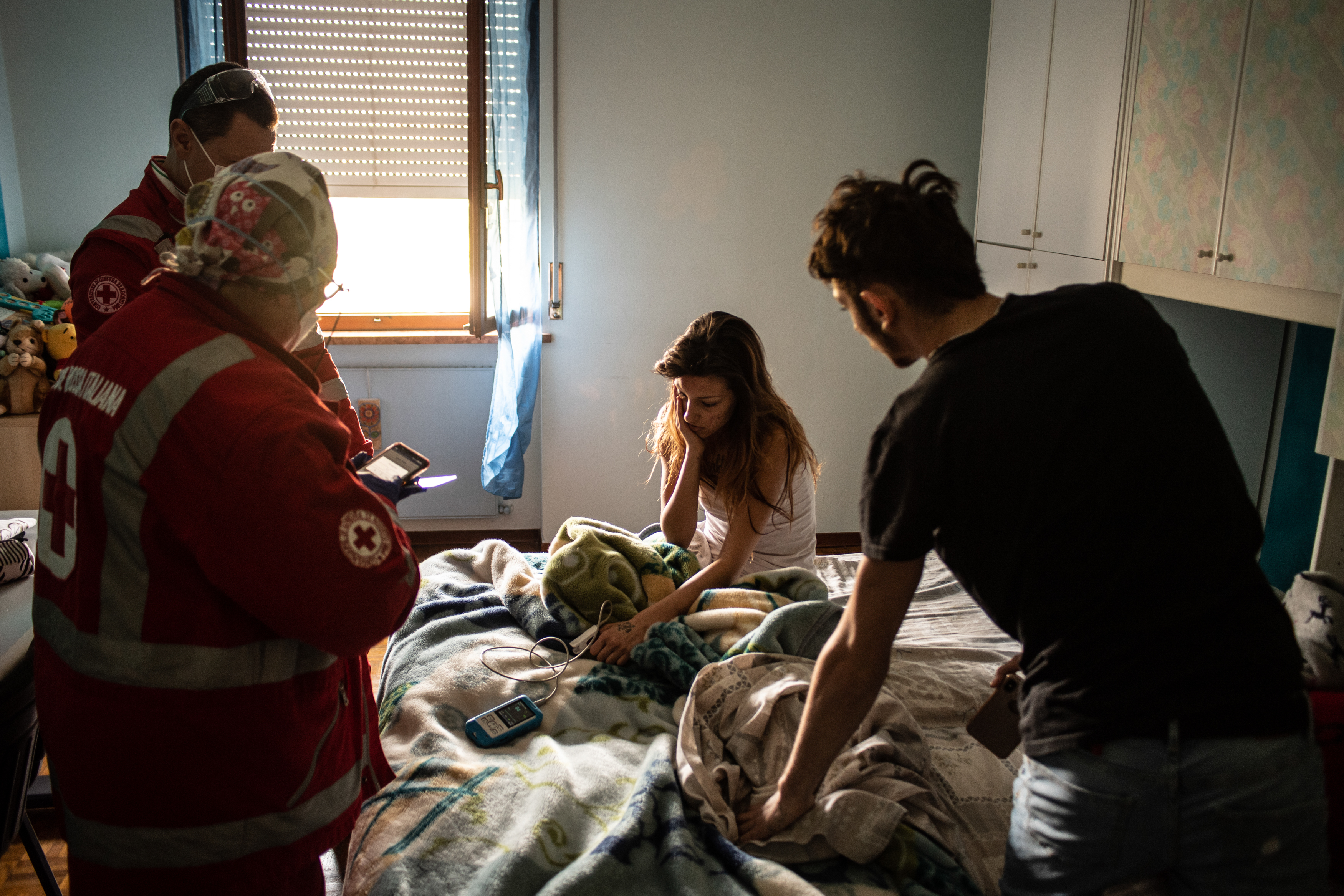
A young and very thin girl living with her boyfriend and their two cats in an apartment. The emergency team was instructed about her case; a panic crises. She have been for weeks at home, mostly in the room, lying in the bed, never took a step outside, her boyfriend was telling the rescuers already at the way up climbing the stairs. Her voice was nearly whisperish and her eyes, evasive. She said she felt dizziness and fear. The first was probably caused by a possible overdose of Duloxetine, an anti-depressive sold under the brand Cymbalta, a name she had to repeat twice before the Red Cross rescuer could hear it properly. The second, she confirmed, was “tutto questo casino” or all this mess, as it’s said in Italian. The last days have been difficult, she mentioned, they stopped watching the internet, her boyfriend confirmed, because, “the situation the world was going through didn’t helped anyone to be feeling well”, he said. The rescuers called the central and suggested they should take her to the hospital and a few minutes later, she was standing just on the side of the door she had been avoiding for many days. Her hands were shaking and one of the rescuers asked why, I’m afraid she said. “Don’t worry, you will be well treated there, by the end of the day, they will let you come back” said the rescuer blocking a cat trying to escape the apartment with her feet.
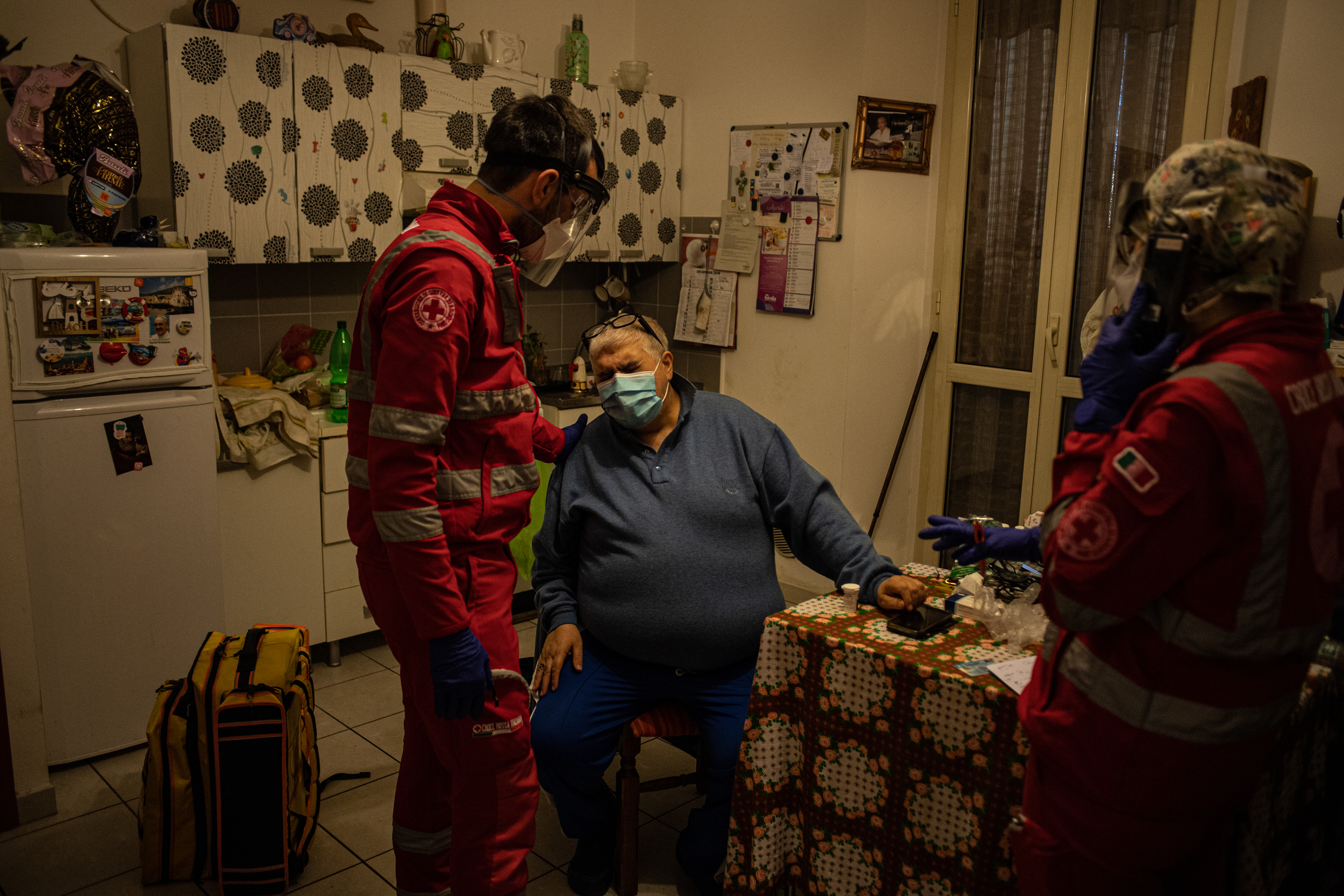
A 58 years old man living alone in his apartment. He complained of nearly unbearable pain in his back that took all his capacity to breath he said. There was nearly 3 days he couldn’t sleep properly fearing do die during the night. He suffered of obesity, hypertension, diabetes and several other minor and more complicated conditions that could be expressed by the large variety of drugs he had over his kitchen table. “I stayed all this weeks at home” he said. The volunteers at the civil defense brought him food and other indispensable itens. “All the things that have happened in the hospital made me think that the best was to be at home”. The Red Cross rescuers defined his basic vital signals as unstable, he complied of nausea, blinding dizziness and suffocating breathlessness. After talking with the Central, the rescuers decided to take him to the hospital. He asked to call a woman he said was his sister. On the other side of the line she was affectionate and concerned to keep him calm. Don’t worry my dear, all that will be finished soon, you don’t need to fear the hospital” the woman said.
Brazil
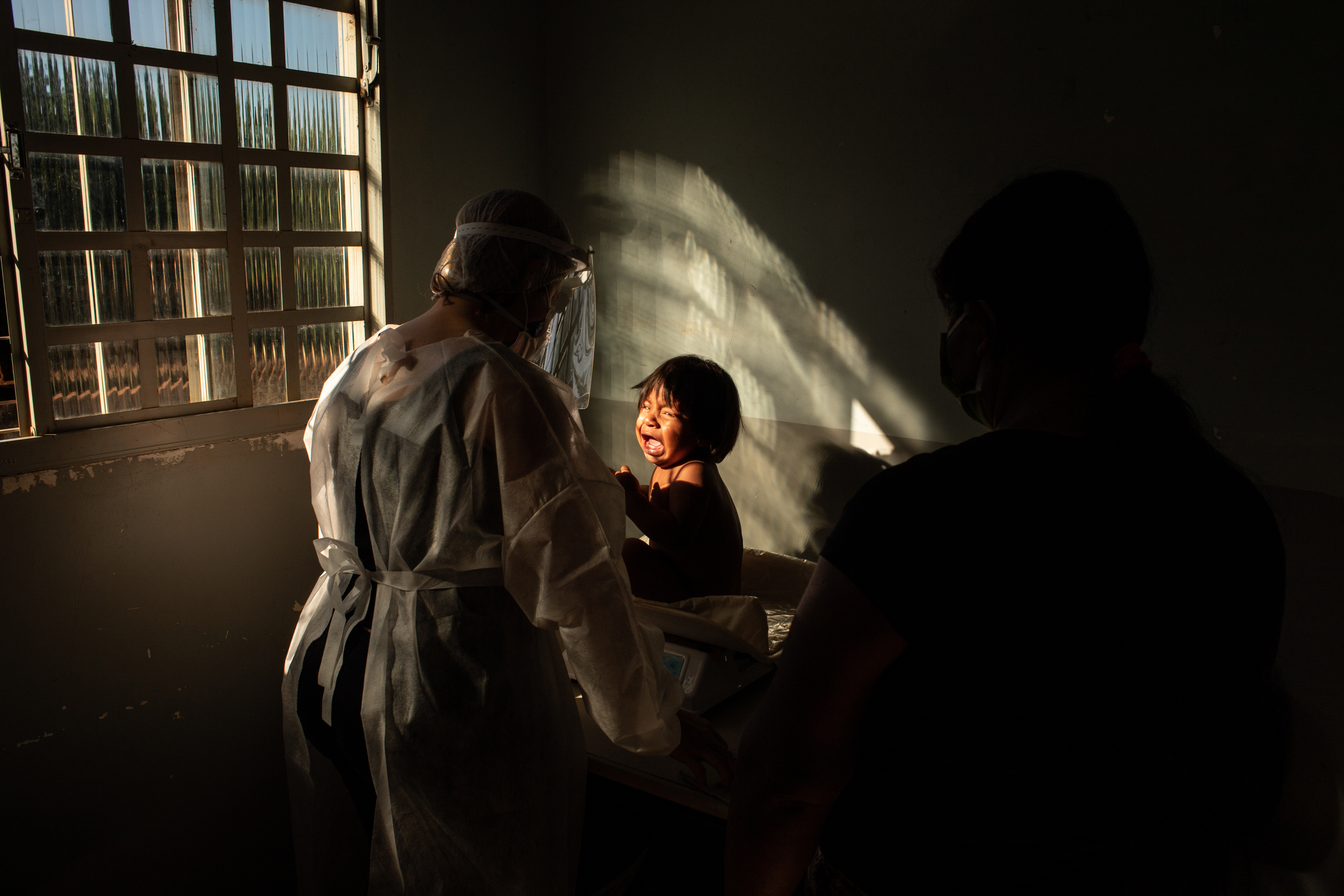
With 2150 confirmed cases of COVID-19 until June 24, 2020, the city of Dourados, with 210 thousand inhabitants, is the main focus of the disease in the state of Mato Grosso do Sul. The two indigenous villages in the region, Jaguapiru and Bororó, add up to approximately 20 thousand inhabitants and are among the communities most affected by the epidemic which, in addition to the risk of death, also exposes their inhabitants to extreme eco-economic difficulties. The indigenous health department started testing the population trying to identify those who have already contracted the disease and who have not yet manifested their symptoms. Since May 15th, in the indigenous communities in Dourados, 16 children have been diagnosed with the new coronavirus. The information was confirmed by the Crisis Management Committee during an online press conference held on June 22nd. According to the Committee, these children vary from 1, to 9 years old and are part of the family network of the first confirmed case in the Reserve and are all being monitored. All of these children are asymptomatic, and only one with mild symptoms. The main vulnerability of the Brazilian indigenous populations in the face of the new coronavirus is the lack of access to quality health care. The existing health care system thought for the Indigenous community, has few resources and infrastructure to treat severe cases, as has been necessary during this epidemic. The lack of access to health is also related to the social and environmental conditions under which these populations live, Andrey Moreira Cardoso, a researcher at Fiocruz and a member of Abrasco's indigenous health group. Among them are geography and indigenous ways of life. The 2020 COVID-19 pandemic was confirmed to have spread to Brazil on 25 February 2020, when a man from São Paulo tested positive for the virus. As of 10 May 2020, 156,862 cases have been confirmed in the country, causing 10,627 deaths. The pandemic has triggered a vari
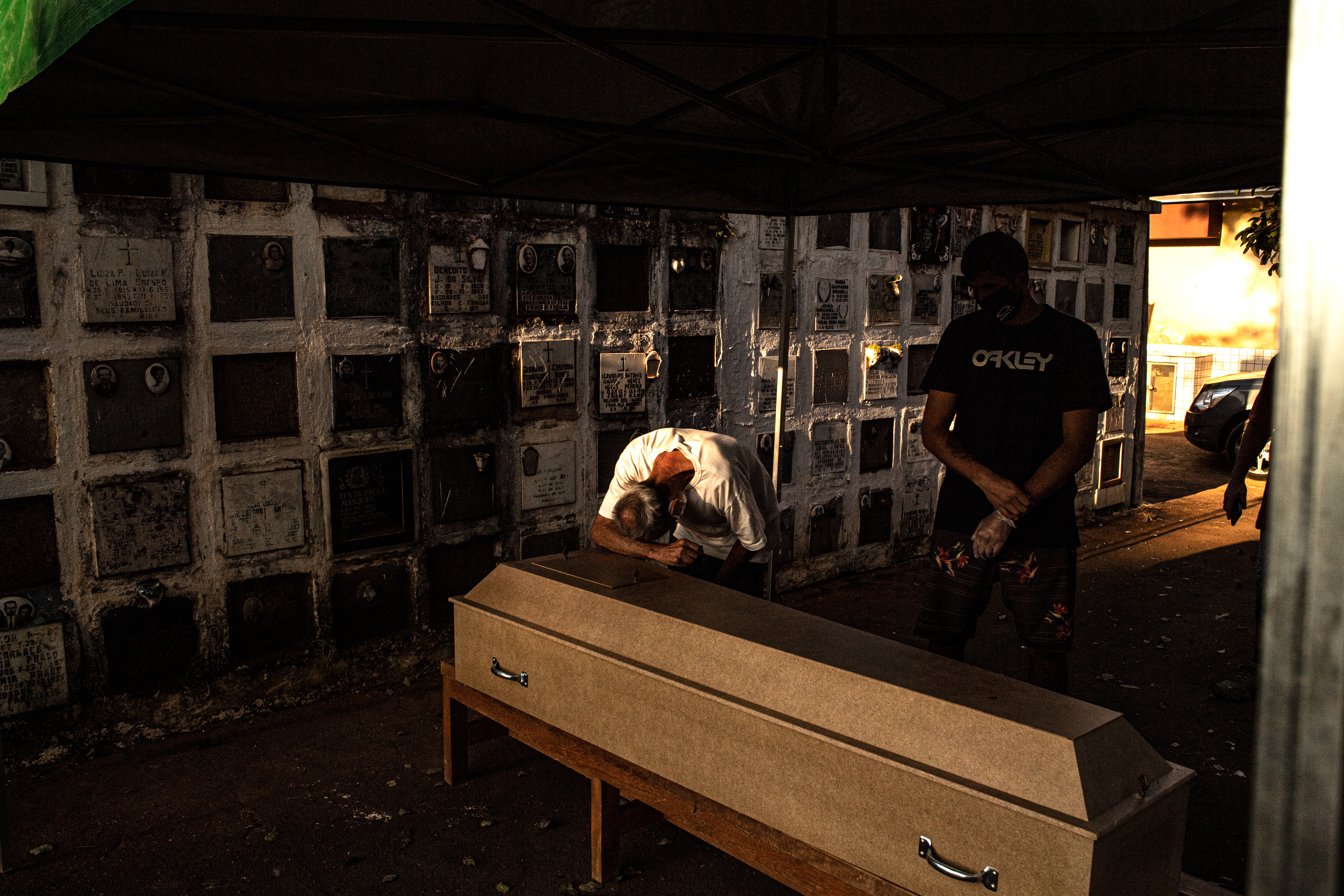
The largest burial ground in Latin America, Sao Paulo's Vila Formosa cemetery, has been prepared to respond the increase in deaths related to the coronavirus outbreak in Brazil. The city's mayor, Bruno Covas, announced that 13,000 new graves would be prepared in the municipal cemeteries on Thursday of last week. According to reports, the plan is to dig 8,000 new tombs in the Vila Formosa cemetery, while in the Vila Nova Cachoerinha and Sao Luis cemeteries some 5,000 will be opened. According to data from the Brazilian Health Ministry, Sao Paulo is the most affected state with 65.000 cases of COVID-19 and 4,500 related deaths. In total, 235,000 cases and 16.000 deaths have been reported in the country to date. In this picture, a man cries over the coffin of his wife. She died of respiratory problems and until the day of her burial, the test confirming if she was a COVID19 victim or not was not yet ready. Her husband asked several times to open the coffin to see her a last time but his family and employees at the cemetery stoped him.
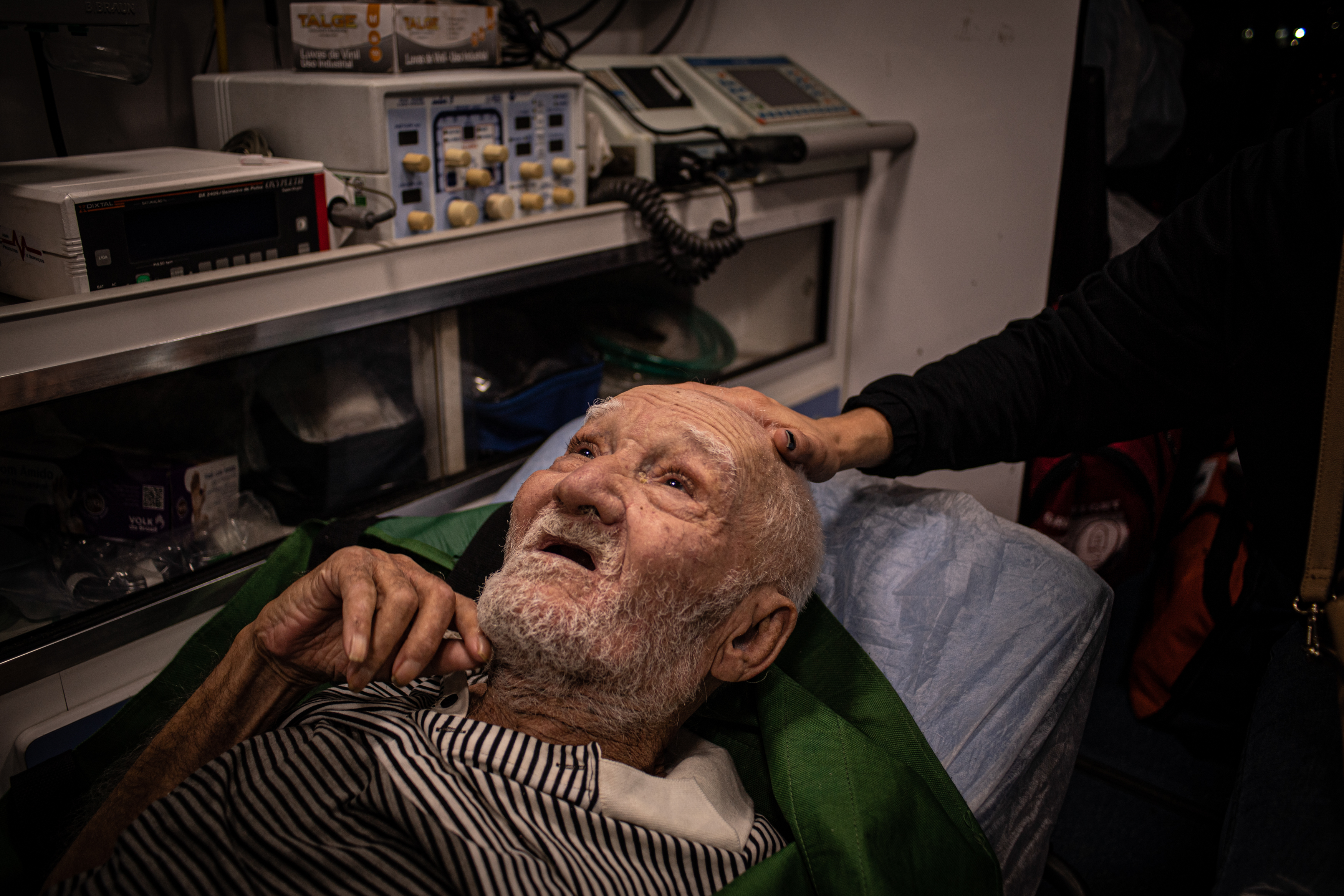
Mistrustful of state, leaders from the biggest slum in the city of Sao Paulo hires own doctors to fight virus. A 89 years old man with severe symptoms of COVID 19 being rescued. The man was heavily ill not eating for at least a week. He, however, didn’t want to be taken to the hospital and asked several times to be left at home. His family however, authorised the ambulance workers to take him to the nearest emergency clinic. Most Paraisópolis residents live in houses in narrow, crooked alleyways, where the ambulance can’t pass through. In these cases the rescuers have to use stretchers to carry the patients. Initially, the ambulance service contracted by the Paraisópolis community should only deal with cases related to COVID-19, but quickly the service had to be extended to practically all other emergency cases within the community that had never before been benefited by an emergency service. The public ambulance service does not serve the favela population, claiming the impossibility of finding homes that are often in areas accessible only on foot and also due to the lack of security created by armed criminal groups operating in the community. The population density in Paraisopolis is about the same as Manhattan, although most buildings are just two or three stories tall. Residents complain the water runs dry after 8 p.m. and rubbish piles up along the tight, damp alleyways that weave through the community. Brazil has reported over 240,000 coronavirus cases since the start of the outbreak. Over 16,000 people have died who were established to have contracted the virus. The 2020 COVID-19 pandemic was confirmed to have spread to Brazil on 25 February 2020, when a man from São Paulo tested positive for the virus. As of 10 May 2020, 156,862 cases have been confirmed in the country, causing 10,627 deaths. The pandemic has triggered a variety of responses from federal, state and local governments, with an impact on politics, education and the economy. On
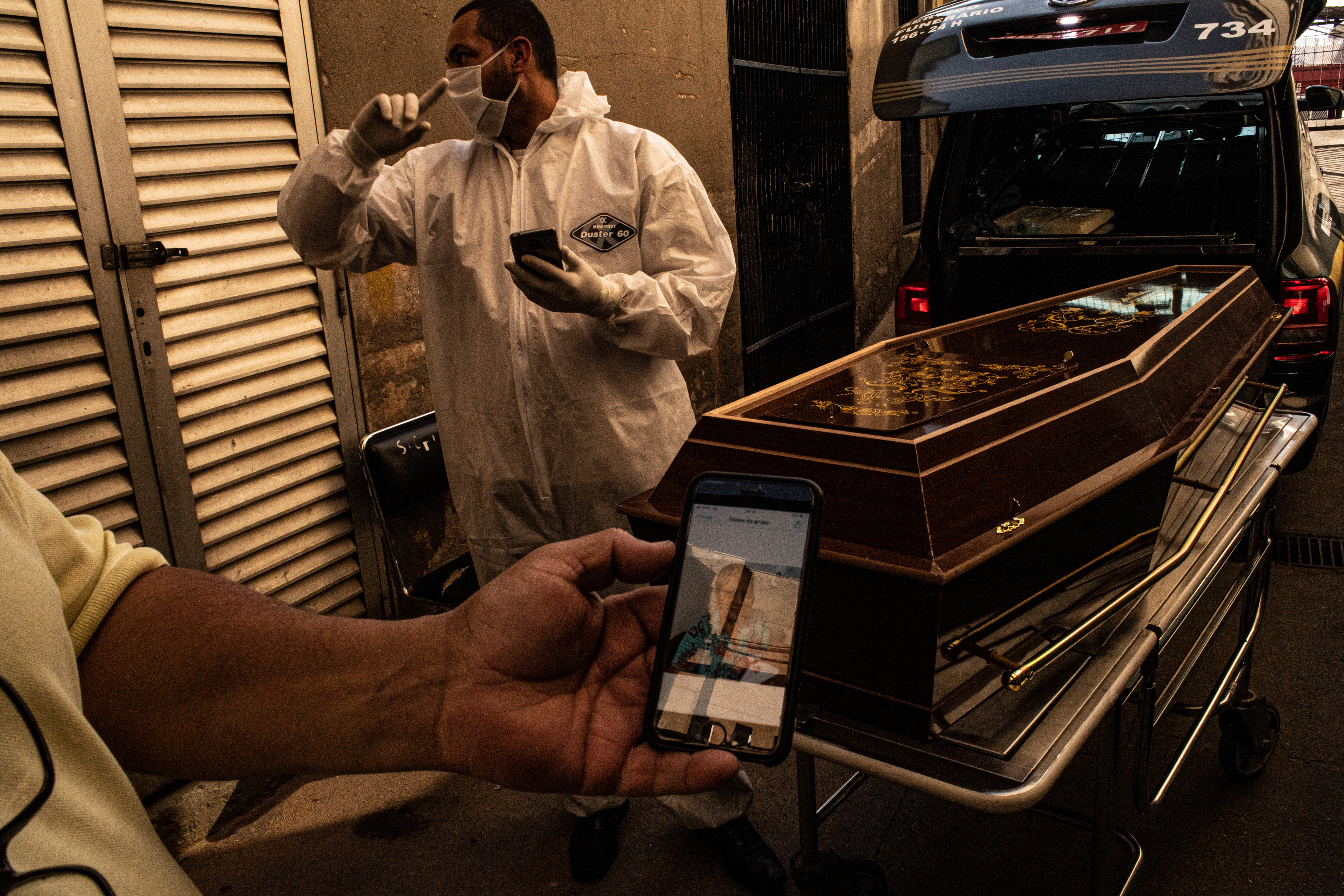
Employees of the municipal funeral service of the city of São Paulo at the Tide Setubal hospital to collect the body of a 72-year-old patient victim of COVID19. The victim had been hospitalised for 18 days before she died. The City of São Paulo has a network of 19 municipal hospitals. Nine of them became a reference for the care of patients with coronavirus symptoms, including Tide Setúbal. Most deaths in the largest city in Latin America occurred on the fringes of the city. There is no updated map of deaths by region, but the new general figures are not very encouraging. By May 28th, 52.719 persons have been infected and 3.958 persons died. Only one in three severe COVID-19 patients who are intubated in Brazilian ICUs recover and are able to return home. The mortality of these patients is 66%, a very high number when compared to international ones. According to experts, the percentage reflects the precariousness of the country's health system and, eventually, the indiscriminate use of drugs without scientifically proven benefits, such as chloroquine. The conclusion is a survey of the Brazilian UTIs Project, the Brazilian Association of Intensive Medicine (Amib) and Epimed - a tool for data analysis and hospital performance. The collection of information was carried out between March 1st and May 15th in 450 hospitals across Brazil, involving 13,600 intensive care beds - which is equivalent to about one-third of the places for adults in these units. The 2020 COVID-19 pandemic was confirmed to have spread to Brazil on February 25th 2020, when a man from São Paulo tested positive for the virus. As of May 10th 2020, 156,862 cases have been confirmed in the country, causing 10,627 deaths. The pandemic has triggered a variety of responses from federal, state and local governments, with an impact on politics, education and the economy. On March 27th, Brazil announced a temporary ban on foreign air travellers, and most state governors have imposed quarantines to

Mistrustful of state, leaders from the biggest slum in the city of Sao Paulo hires own doctors to fight virus. 34 years old women had a panic attack at home when she started to feel her breath short and pain in her chest. The doctors arrived and tried to calm her down. During the crises, she had hallucinations that her 8 years old son had died. Initially, the ambulance service contracted by the Paraisópolis community should only deal with cases related to COVID-19, but quickly the service had to be extended to practically all other emergency cases within the community that had never before been benefited by an emergency service. The public ambulance service does not serve the favela population, claiming the impossibility of finding homes that are often in areas accessible only on foot and also due to the lack of security created by armed criminal groups operating in the community. The population density in Paraisopolis is about the same as Manhattan, although most buildings are just two or three stories tall. Residents complain the water runs dry after 8 p.m. and rubbish piles up along the tight, damp alleyways that weave through the community. Brazil has reported over 240,000 coronavirus cases since the start of the outbreak. Over 16,000 people have died who were established to have contracted the virus. The 2020 COVID-19 pandemic was confirmed to have spread to Brazil on 25 February 2020, when a man from São Paulo tested positive for the virus. As of 10 May 2020, 156,862 cases have been confirmed in the country, causing 10,627 deaths. The pandemic has triggered a variety of responses from federal, state and local governments, with an impact on politics, education and the economy. On 27 March Brazil announced a temporary ban on foreign air travellers, and most state governors have imposed quarantines to prevent the spread of the virus. The view of the President of Brazil, Jair Bolsonaro, is that the risk posed by coronavirus has been exaggerated. State go
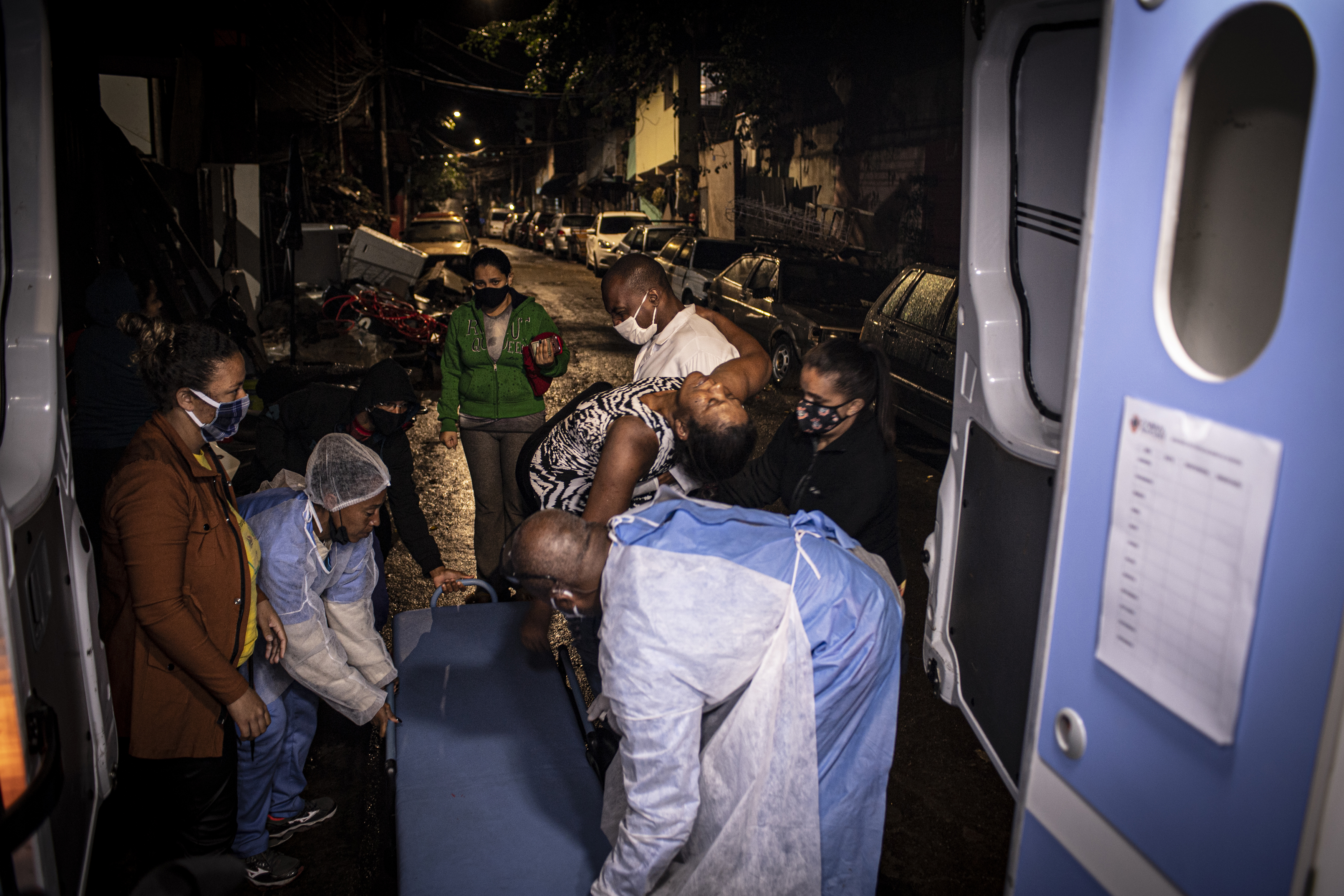
Mistrustful of state, leaders from the biggest slum in the city of Sao Paulo hires own doctors to fight virus. The ambulance team rescuing a 60 years old women that was having a heart attack. Initially, the ambulance service contracted by the Paraisópolis community should only deal with cases related to COVID-19, but quickly the service had to be extended to practically all other emergency cases within the community that had never before been benefited by an emergency service. The public ambulance service does not serve the favela population, claiming the impossibility of finding homes that are often in areas accessible only on foot and also due to the lack of security created by armed criminal groups operating in the community. The population density in Paraisopolis is about the same as Manhattan, although most buildings are just two or three stories tall. Residents complain the water runs dry after 8 p.m. and rubbish piles up along the tight, damp alleyways that weave through the community. Brazil has reported over 240,000 coronavirus cases since the start of the outbreak. Over 16,000 people have died who were established to have contracted the virus. The 2020 COVID-19 pandemic was confirmed to have spread to Brazil on 25 February 2020, when a man from São Paulo tested positive for the virus. As of 10 May 2020, 156,862 cases have been confirmed in the country, causing 10,627 deaths. The pandemic has triggered a variety of responses from federal, state and local governments, with an impact on politics, education and the economy. On 27 March Brazil announced a temporary ban on foreign air travellers, and most state governors have imposed quarantines to prevent the spread of the virus. The view of the President of Brazil, Jair Bolsonaro, is that the risk posed by coronavirus has been exaggerated. State governors have openly disagreed, imposing lockdowns in their own states. (Source WIKIPEDIA)
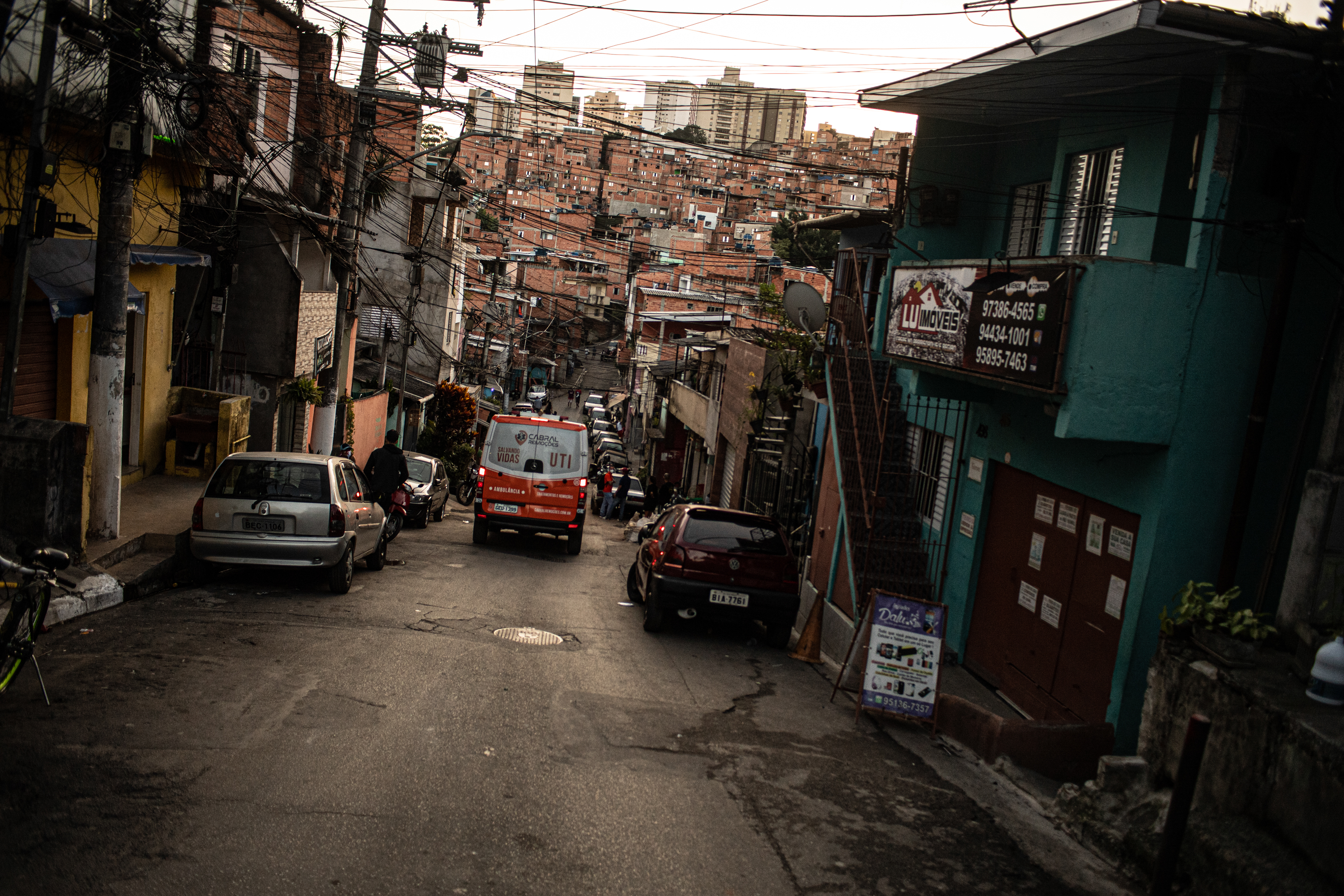
Mistrustful of state, leaders from the biggest slum in the city of Sao Paulo hires own doctors to fight virus. The population density in Paraisopolis is about the same as Manhattan, although most buildings are just two or three stories tall. Residents complain the water runs dry after 8 p.m. and rubbish piles up along the tight, damp alleyways that weave through the community. Brazil has reported over 240,000 coronavirus cases since the start of the outbreak. Over 16,000 people have died who were established to have contracted the virus. The 2020 COVID-19 pandemic was confirmed to have spread to Brazil on 25 February 2020, when a man from São Paulo tested positive for the virus. As of 10 May 2020, 156,862 cases have been confirmed in the country, causing 10,627 deaths. The pandemic has triggered a variety of responses from federal, state and local governments, with an impact on politics, education and the economy. On 27 March Brazil announced a temporary ban on foreign air travellers, and most state governors have imposed quarantines to prevent the spread of the virus. The view of the President of Brazil, Jair Bolsonaro, is that the risk posed by coronavirus has been exaggerated. State governors have openly disagreed, imposing lockdowns in their own states. (Source WIKIPEDIA)
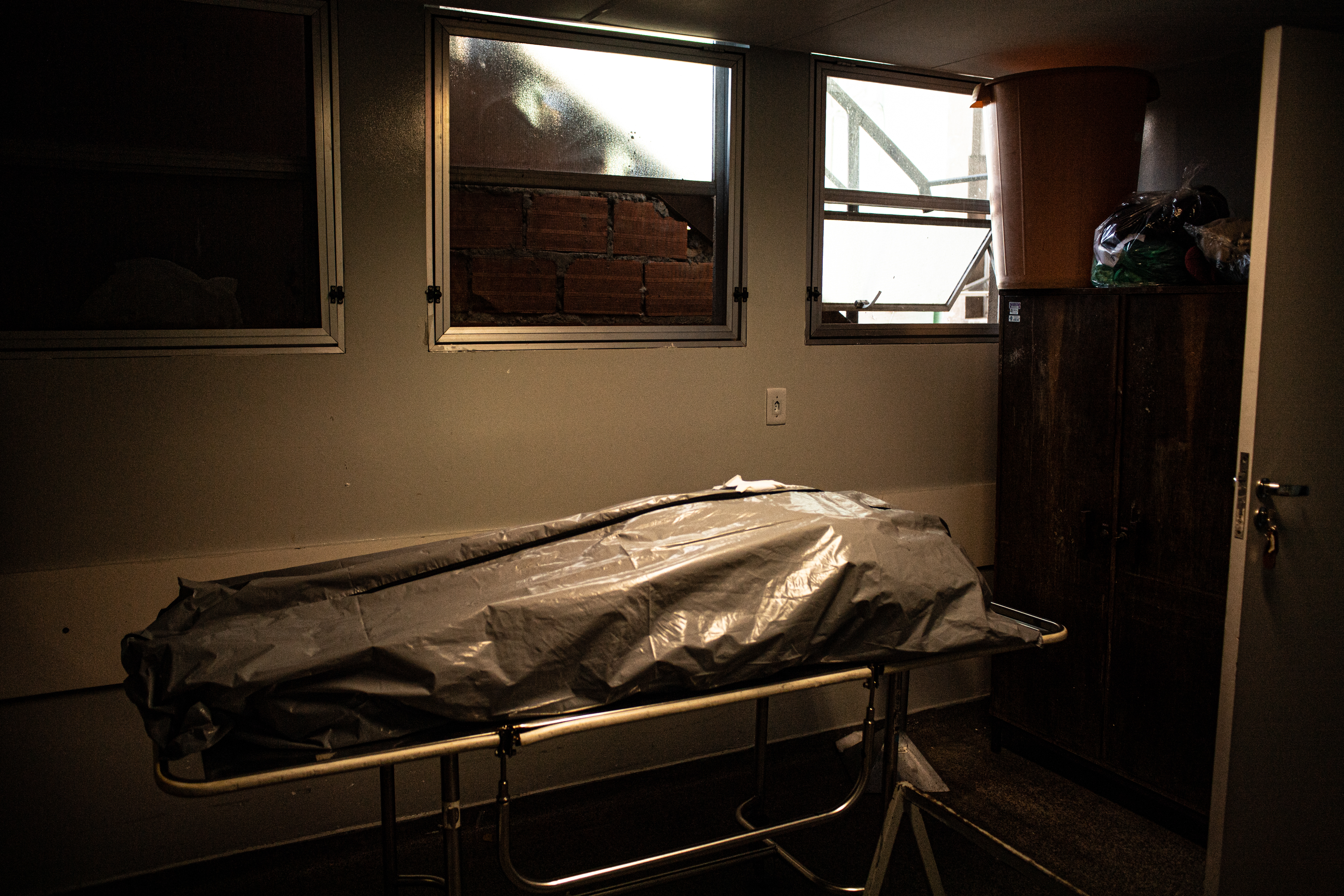
the body of a 72-year-old woman, a victim of COVID-19 The victim had remained in the hospital for 18 days before she died. The City of São Paulo has a network of 19 municipal hospitals. Nine of them became a reference for the care of patients with coronavirus symptoms, including Tide Setúbal. Most deaths in the largest city in Latin America occurred on the fringes of the city. There is no updated map of deaths by region, but the new general figures are not very encouraging. By May 28th, 52.719 persons have been infected and 3.958 persons died. Only one in three severe COVID-19 patients who are intubated in Brazilian ICUs recover and are able to return home. The mortality of these patients is 66%, a very high number when compared to international ones. According to experts, the percentage reflects the precariousness of the country's health system and, eventually, the indiscriminate use of drugs without scientifically proven benefits, such as chloroquine. The conclusion is a survey of the Brazilian UTIs Project, the Brazilian Association of Intensive Medicine (Amib) and Epimed - a tool for data analysis and hospital performance. The collection of information was carried out between March 1st and May 15th in 450 hospitals across Brazil, involving 13,600 intensive care beds - which is equivalent to about one-third of the places for adults in these units. The 2020 COVID-19 pandemic was confirmed to have spread to Brazil on February 25th 2020, when a man from São Paulo tested positive for the virus. As of May 10th 2020, 156,862 cases have been confirmed in the country, causing 10,627 deaths. The pandemic has triggered a variety of responses from federal, state and local governments, with an impact on politics, education and the economy. On March 27th, Brazil announced a temporary ban on foreign air travellers, and most state governors have imposed quarantines to prevent the spread of the virus. The view of the President of Brazil, Jair Bolsonaro, is that the ri
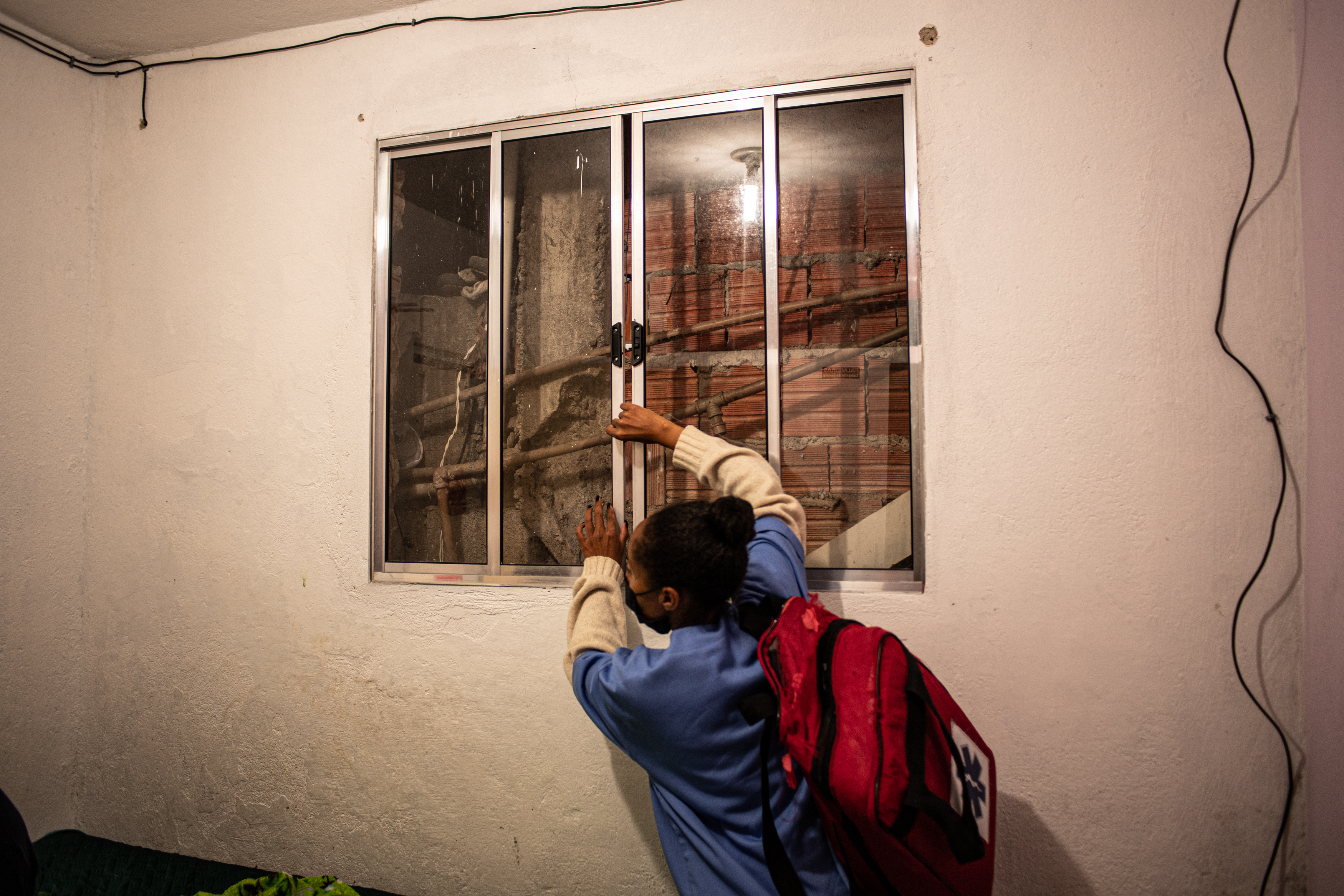
Mistrustful of state, leaders from the biggest slum in the city of Sao Paulo hires own doctors to fight virus. Rescuer Renata Alves opening the window where a 32 years old man diagnosed with COVID lived with his wife and mother in a two rooms apartment inside the Paraisópolis Slum. The buildings are raised without any planning and frequently windows are just a few centimetres a part from the next walls. Initially, the ambulance service contracted by the Paraisópolis community should only deal with cases related to COVID-19, but quickly the service had to be extended to practically all other emergency cases within the community that had never before been benefited by an emergency service. The public ambulance service does not serve the favela population, claiming the impossibility of finding homes that are often in areas accessible only on foot and also due to the lack of security created by armed criminal groups operating in the community. The population density in Paraisopolis is about the same as Manhattan, although most buildings are just two or three stories tall. Residents complain the water runs dry after 8 p.m. and rubbish piles up along the tight, damp alleyways that weave through the community. Brazil has reported over 240,000 coronavirus cases since the start of the outbreak. Over 16,000 people have died who were established to have contracted the virus. The 2020 COVID-19 pandemic was confirmed to have spread to Brazil on 25 February 2020, when a man from São Paulo tested positive for the virus. As of 10 May 2020, 156,862 cases have been confirmed in the country, causing 10,627 deaths. The pandemic has triggered a variety of responses from federal, state and local governments, with an impact on politics, education and the economy. On 27 March Brazil announced a temporary ban on foreign air travellers, and most state governors have imposed quarantines to prevent the spread of the virus. The view of the President of Brazil, Jair Bolsonaro, is that
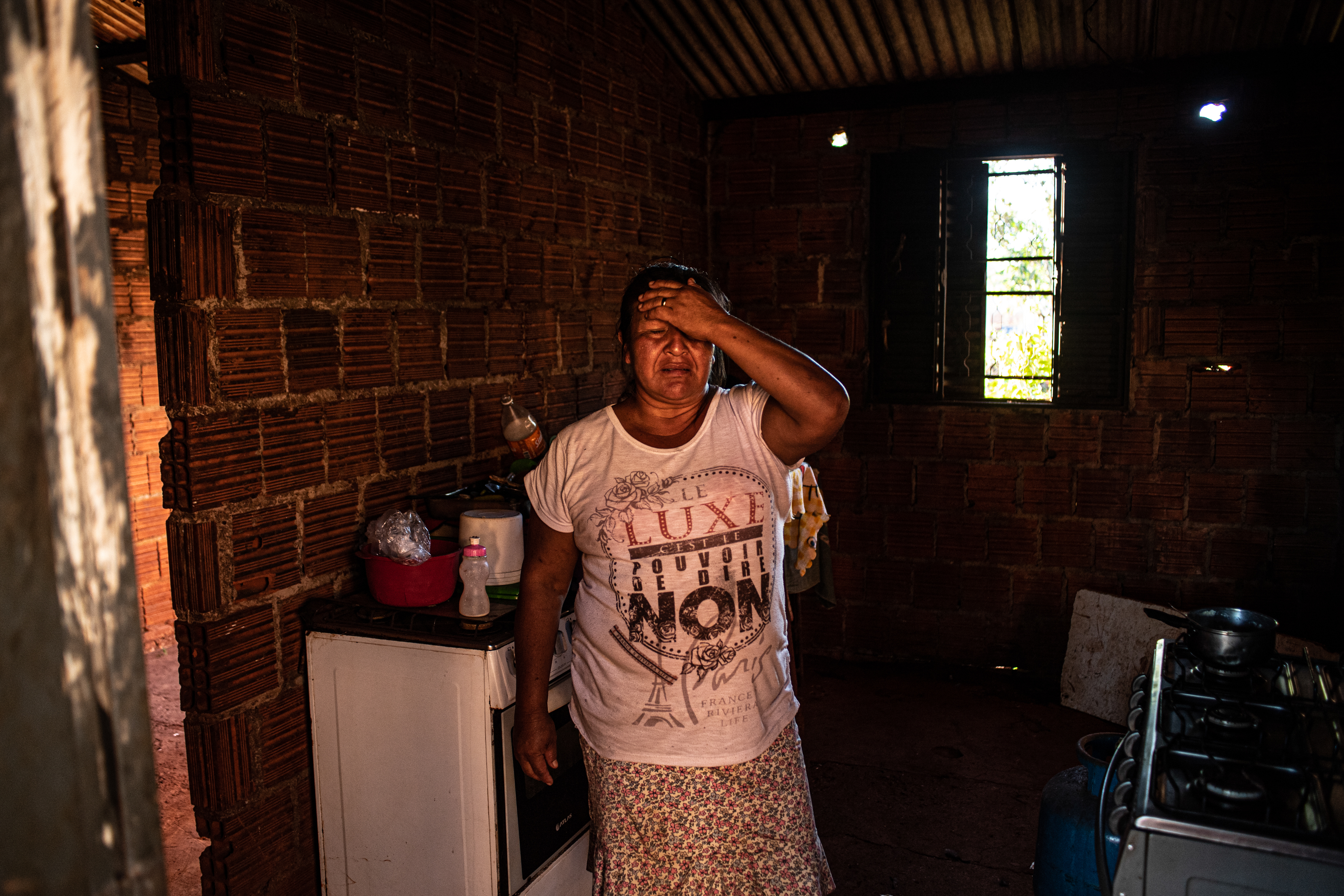
43-year-old Ivone, a native of the Kaiowa ethnicity, was diagnosed with the new coronavirus after her eldest son, 20, was infected while working at the JBS meat processing factory in the city of Dourados. Very poor, Ivone's family still suffers from severe economic difficulties since her son and her husband had to stop working because of the disease. According to her, as soon as her neighbours left and discriminated against them after they learned that the family had been contaminated. "People did not want to pass even in front of our house, and I had no one who could help us with food or medicine." The main vulnerability of the Brazilian indigenous populations in the face of the new coronavirus is the lack of access to quality health care. The existing health care system thought for the Indigenous community, has few resources and infrastructure to treat severe cases, as has been necessary during this epidemic. The lack of access to health is also related to the social and environmental conditions under which these populations live, Andrey Moreira Cardoso, a researcher at Fiocruz and a member of Abrasco's indigenous health group. Among them are geography and indigenous ways of life. The 2020 COVID-19 pandemic was confirmed to have spread to Brazil on 25 February 2020, when a man from São Paulo tested positive for the virus. As of 10 May 2020, 156,862 cases have been confirmed in the country, causing 10,627 deaths. The pandemic has triggered a variety of responses from federal, state and local governments, with an impact on politics, education and the economy. On 27 March Brazil announced a temporary ban on foreign air travelers, and most state governors have imposed quarantines to prevent the spread of the virus. The view of the President of Brazil, Jair Bolsonaro, is that the risk posed by coronavirus has been exaggerated. State governors have openly disagreed, imposing lockdowns in their own states. (Source WIKIPEDIA)
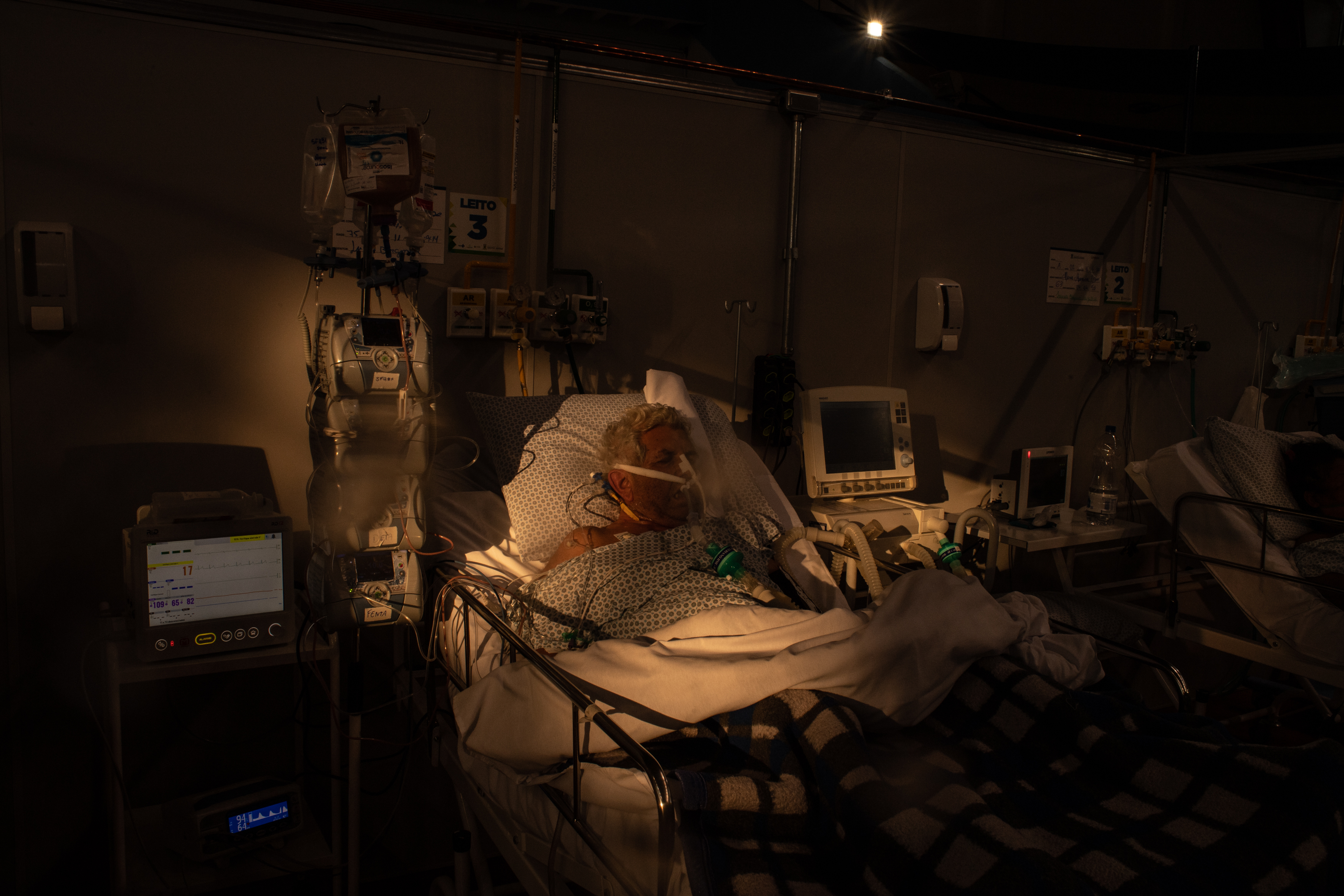
An unconscious male patient diagnosed with COVID-19 from the Santo Andre field hospital. In many cases, the severe pulmonary infection caused by COVID-19, causes the lungs of the infected patients to harden. In these cases, even mechanical respiration through respirators can be inefficient so that the patient's lungs can properly re-oxygenate its blood. The 2020 COVID-19 pandemic was confirmed to have spread to Brazil on 25 February 2020, when a man from São Paulo tested positive for the virus. As of 19 May 2020, 265,896 cases have been confirmed in the country, causing 17,840 deaths. The pandemic has triggered a variety of responses from federal, state and local governments, with an impact on politics, education and the economy. On 27 March Brazil announced a temporary ban on foreign air travelers, and most state governors have imposed quarantines to prevent the spread of the virus. The view of the President of Brazil, Jair Bolsonaro, is that the risk posed by coronavirus has been exaggerated. State governors have openly disagreed, imposing lockdowns in their own states. (Source WIKIPEDIA)
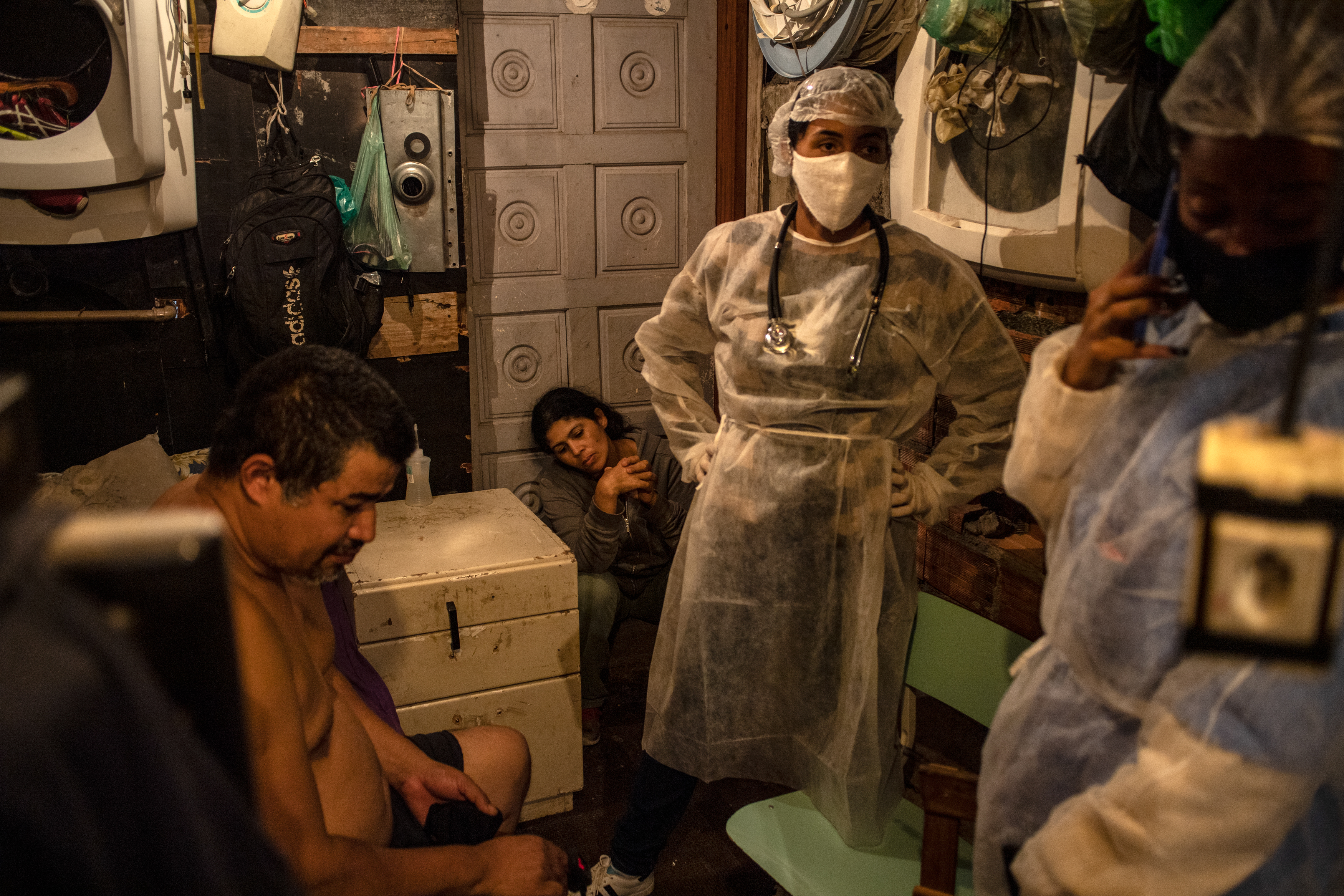
Mistrustful of state, leaders from the biggest slum in the city of Sao Paulo hires own doctors to fight virus. The creation of “street presidents” is one of the actions promoted by the Paraisópolis Residents and Commerce Association to control the impact of the new coronavirus within the second largest favela in São Paulo. Each president has the mission of taking care of 50 families 32 years old Cida is one of the more than 400 “presidents”. Her routine in the neighborhood includes visiting all the houses to update registrations and distribute the baskets with donations. She says she made a group on WhatsApp to be able to communicate better with families. "There are already many emergency cases that I had to take care. A neighbor was feeling sick, short of breath, fever, and I had to rush to call the ambulance. We presidents have a great responsibility for these lives" Initially, the ambulance service contracted by the Paraisópolis community should only deal with cases related to COVID-19, but quickly the service had to be extended to practically all other emergency cases within the community that had never before been benefited by an emergency service. The public ambulance service does not serve the favela population, claiming the impossibility of finding homes that are often in areas accessible only on foot and also due to the lack of security created by armed criminal groups operating in the community. The population density in Paraisopolis is about the same as Manhattan, although most buildings are just two or three stories tall. Residents complain the water runs dry after 8 p.m. and rubbish piles up along the tight, damp alleyways that weave through the community. Brazil has reported over 240,000 coronavirus cases since the start of the outbreak. Over 16,000 people have died who were established to have contracted the virus. The 2020 COVID-19 pandemic was confirmed to have spread to Brazil on 25 February 2020, when a man from São Paulo teste

Rescuers from the SAMU (Emergency Mobile Care Service) in an operation to take a COVID-19 51 years old female patient from the Santo Andre Municipality Hospital to the Santo Andre field hospital where the tomography equipment has been deployed. The patient had been kept in an induced coma so that he could be intubated during his treatment against the disease and after 3 days without receiving any more sedatives, he still had not shown signs of leaving the coma. The doctors suspected that the patient was already brain dead and needed to have a CT scan that confirmed that the patient had several bleeding points inside his brain. The 2020 COVID-19 pandemic was confirmed to have spread to Brazil on 25 February 2020, when a man from São Paulo tested positive for the virus. As of 20 May 2020, 291,579 cases have been confirmed in the country, causing 18,859 deaths. The pandemic has triggered a variety of responses from federal, state and local governments, with an impact on politics, education and the economy. On 27 March Brazil announced a temporary ban on foreign air travelers, and most state governors have imposed quarantines to prevent the spread of the virus. The view of the President of Brazil, Jair Bolsonaro, is that the risk posed by coronavirus has been exaggerated. State governors have openly disagreed, imposing lockdowns in their own states. (Source WIKIPEDIA)
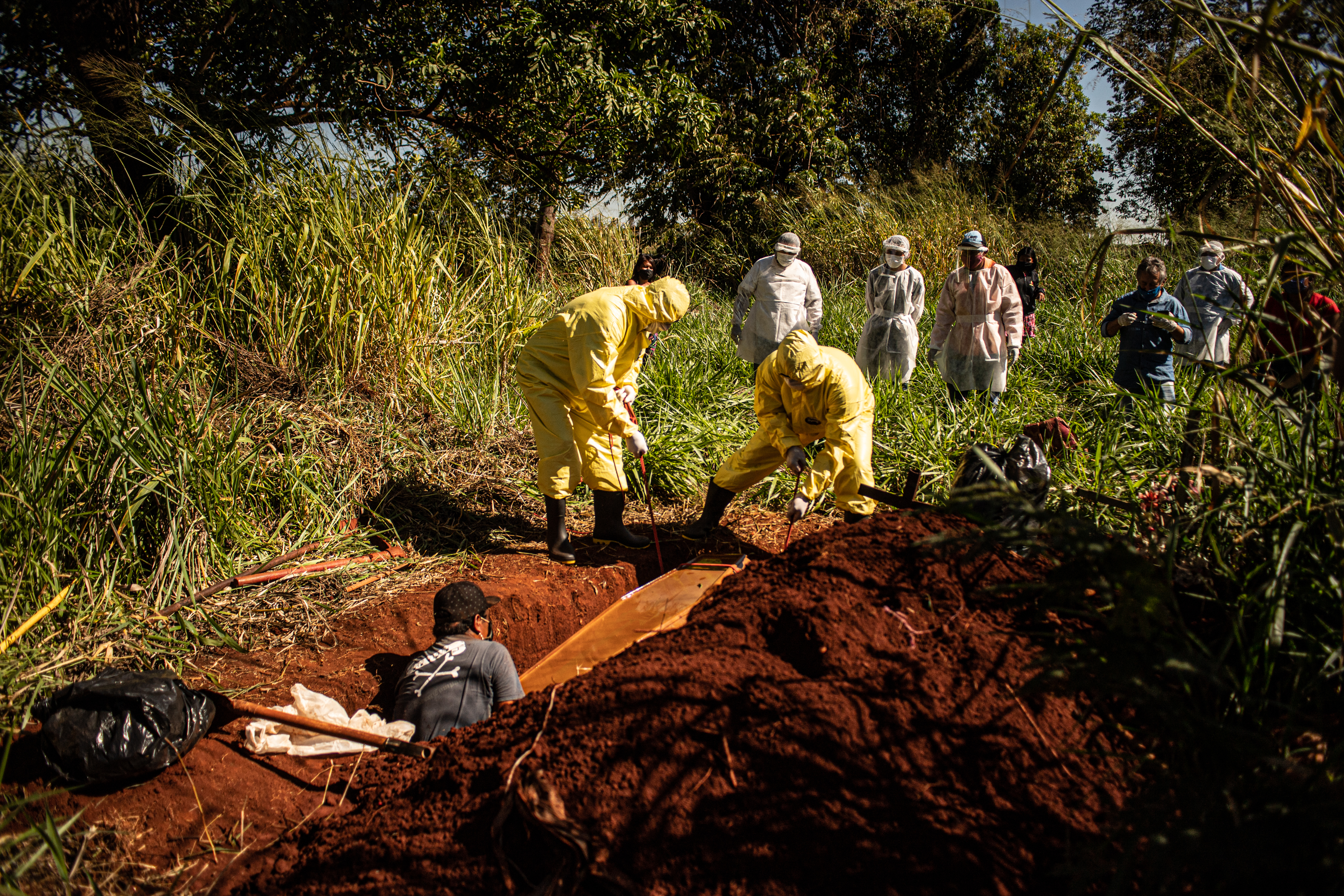
As sad as the reason for his death, 52 years old Evaristo Garcete’s burial, shows the reality of indigenous peoples in the country in the face of the coronavirus pandemic (covid-19). Being buried beside his wife and youngest son, Evaristo's grave was dug by his eldest son inside Aldeia Bororó, in Dourados, 225 kilometers from Campo Grande. Diabetic, Evaristo had been hospitalized since June 7 at Hospital Evangélico and belonged to the Guarani Kaiowá ethnicity and death by covid-19 was confirmed on Friday (19), being the 40th fatal victim of the disease that has already killed 41 in Mato Grosso do Sul. In the country, according to the Apib (Articulation of the Indigenous Peoples of Brazil), until this Friday, 301 indigenous people had already died from the covid1-9 and 6,352 were infected by the coronavirus in 103 people. Described by his eldest son, Everton Garcia Garcete as a hard working man, Evaristo died without being able to retire. “He helped to build Brazil, working in alcohol plants, on highways and what did he gain from it? Just a meagre salary and no rights as a human being? As a citizen? As a Brazilian? As an indigenous man? Because he was a native, pure Guarani. Where is it? ”, Says. While working in the pit where his father's body will be placed, Everton is moved to remember that death is the result of such a dangerous disease. “He died attacked by a disease that was not part of our everyday life. Work, live, fight and die without the right to anything? It's sad. It's very sad, ”says Everton as he opens the ditch where Evaristo's coffin will be placed. “Me too, I didn’t believe in the disease. But as the days went by we saw the changes happening and we saw that it was serious, only it is difficult to keep isolated from the city. It is not every day that we have money to buy a bundle of chicken to eat and be quarantined ”, he details. According to him, the father lived in the reserve, but just like the other indigenous people ne
